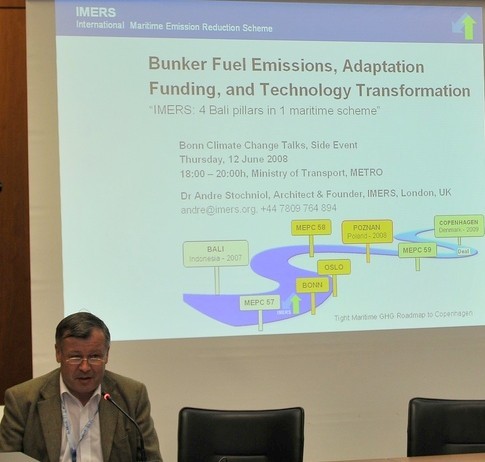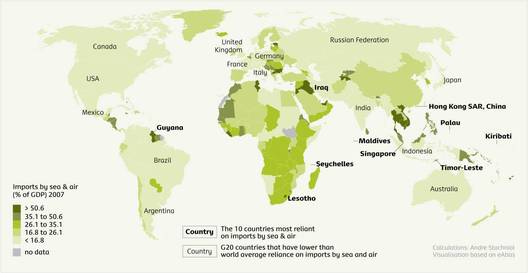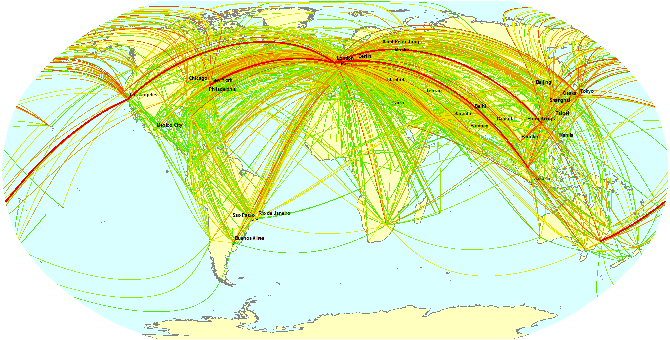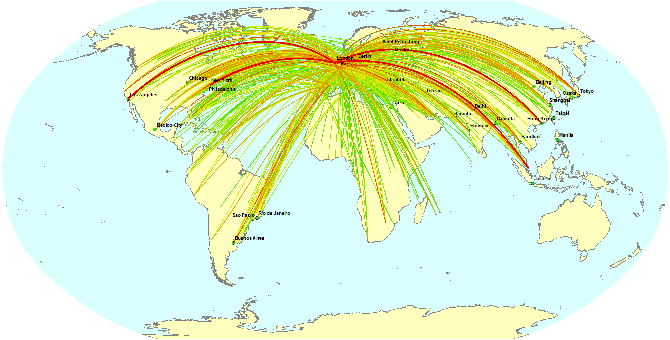Negotiations
The three generations of the IMERS proposal have been discussed at the UNFCCC/IMO negotiations and other fora since 2007. The following links provide summary of the most relevant meetings.
@ Bali: IMERS & IATAL - Emissions and Adaptation Financing
We held an official side event at the UNFCCC COP 13
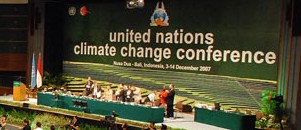

meeting in Bali on:
- Bunker Fuel Emissions and Adaptation Funding
The presentation from the event is available for download
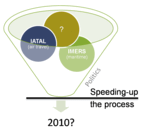
- Two main proposals were discussed in details:
- IATAL
 (0.7 MB), an International Air Travel Adaptation Levy
(0.7 MB), an International Air Travel Adaptation Levy
- IMERS
 (0.1 MB), see the special 2-page IMERS synopsis prepared for Bali
(0.1 MB), see the special 2-page IMERS synopsis prepared for Bali
- The goal was twofold:
- Increasing momentum and furthering our scheme for international maritime emissions
- Simultaneously reducing the gap in financing for adaptation
- The event has been recognized and reported by the Earth Negotiations Bulletin. The reports from the selected events held on 05 Dec are available:
- web version with additional pictures
- shorter pdf version
 (1 MB)
(1 MB)
Extra Events & News
Monday, 10 Dec
A site event was held by Norway on:
International GHG emissions from aviation and maritime transport - follow up of the seminar in Oslo 4-5 October 07. Official workshop conclusions are available ![]() (0.1 MB; SBSTA/2007/MISC.29).
(0.1 MB; SBSTA/2007/MISC.29).
Presentations were given by:
- André Jol, European Environment Agency, Conclusions from the Oslo Workshop
 (0.1 MB)
(0.1 MB)
- Miguel Palomares, IMO (no presentation; Mr M. Palomares stressed the importance of international shipping to the global economy. He also outlined the current IMO GHG activities, including a correspondence group to consider technical, operational and market-based approaches to reducing GHG emissions.)
- Marit Viktoria Pettersen, Ministry of Environment, Norway, Norwegian GHG proposal to IMO
 (0.2MB)
(0.2MB)
- Jakob Graichen, Öko-Institut, Germany, Options on aviation post-2012
 (0.3MB)
(0.3MB)
- Stefan Seum, Stefan Seum Consulting, Options on shipping post-2012
 (0.2 MB)
(0.2 MB)
A short report from the event is available at the IISD RS Blog.
Saturday, 08 Dec
Tuvalu has submitted an International Blueprint on Adaptation ![]() (0.2 MB) to COP 13. A novel Burden Sharing Mechanism is proposed comprising a levy on international airfares and maritime transport freight charges. Something very close to IMERS. The main differences is that it does not include emission reductions. Additionally, the raised funds will be significantly lower based on the quoted 0.01% base levy. Not the best starting point perhaps to reach a rapid consensus on innovative means to raise the significant funds needed to reduce the gap in financing for adaptation ....(our humble view).
(0.2 MB) to COP 13. A novel Burden Sharing Mechanism is proposed comprising a levy on international airfares and maritime transport freight charges. Something very close to IMERS. The main differences is that it does not include emission reductions. Additionally, the raised funds will be significantly lower based on the quoted 0.01% base levy. Not the best starting point perhaps to reach a rapid consensus on innovative means to raise the significant funds needed to reduce the gap in financing for adaptation ....(our humble view).
Friday, 07 Dec
- We presented IMERS as the only concrete proposal for the post-2012 regime for international maritime transport at a side event organized by the International Emissions Trading Association, IETA entitled:
- What is the scope for including international marine transport in the post-2012 regime?
- on Friday, 07 Sept.
- Presentation is enclosed
 (0.2MB).
(0.2MB).
However, an approach to agree underlying climate change principles for such a scheme is needed within the UNFCCC/SBSTA/SBI. The current process is unlikely to deliver it.
Due to this problem IMO is unlikely to be able to decide on any global scheme until the principle of "Common but differentiated responsibilities" is clearly addressed.
A facilitated 1-year approach using IMERS as a strawman to jointly shape a solution and build the required trust around concrete details could break the deadlock. This is now being actively pursued by us based on discussions with very senior officials.
Bali Outcomes & Impressions
At the UNFCCC COP 13 a Bali Action Plan ![]() (0.1 MB) has been agreed that launches inclusive negotiations on post-2012 with an end date of 2009. IMERS would deliver on the four pillars of the Bali Roadmap/Deal.
(0.1 MB) has been agreed that launches inclusive negotiations on post-2012 with an end date of 2009. IMERS would deliver on the four pillars of the Bali Roadmap/Deal.

For impressions and suggestions from Bali jump to On the Road again!
- The talks will address, inter alia,
- Long-term goal for global greenhouse gas emissions reductions
- Enhanced action on mitigation, adaptation, technology development and transfer, and finance and investment
Reducing the gap in financing for adaptation
We were very pleased with the very positive feedback on our IMERS proposal in Bali. When implemented, it will deliver the four major blocks of the Bali roadmap for international shipping. We are actively pursuing buy-in activities.
On the road again! - Impressions from COP 13 UNFCCC
Short extracts from a full paper- The aim of the recent UN climate change conference in Nusa Dua (Bali, Indonesia) was widely held to be two-fold.
- To finalise the operational details of the Kyoto Protocol Adaptation Fund (AF), and
- to put together a ‘Road Map’ for negotiations on strengthening the UN climate change regime beyond the initial commitments of the Kyoto Protocol which expire in 2012.
The Adaptation Fund
[...] The key to the astonishingly smooth progress and the early breakthrough in the negotiations on the AF was no doubt the absence of surprises and a raised level of trust [...] This was in stark contrast to the other key negotiations strand on the Bali Road Map which, particularly in the final phase, turned out to have a number of very unfortunate surprises with a concomitant loss of trust.
The Bali Roadmap: The many plots of the Ides of December
Of Contact and Small Groups
[...] The one issue that eluded consensus in the small ministerial group was the relevant paragraph (1.b.ii) on the scope of developing country mitigation activities to be considered in the proposed Convention-track negotiations. [...]
The multi-plot plenary
[...] At this point the drama started to unfold. Seven seconds after the EU intervention [...]
The unfortunate events of the final morning have turned this into a rather inauspicious beginning, as far as trust building is concerned. [...]
An American "U-turn"?
When the plenary convened for the third time [...]
But to think that the US was swayed by this, or indeed by the jeering after their initial intervention, is simply naïve.
The Way Forward: To Ensure a Safe Journey
[...] As to the medium term, the difficulty will be to find tools to ‘square the global mitigation circle,’ that is to break out of the “we-will-only-take-on-commitments-if-they-do” stalemate which has bedevilled the climate change process ever since the passing of the notorious Byrd-Hagel resolution in the US Senate in 1997 [...] No one ‘in the know’ will underestimate the difficulty of this task. But it is not impossible.
[...] Measurable, reportable and verifiable developing country mitigation commitments will, if at all, only be possible as a package deal with measurable, reportable and verifiable commitments to provide technology, financing and capacity-building by developed countries. Indeed India’s closing statement can and should be read in this spirit:
“The road to Bali was in principle strong, the road from Bali must be much stronger.
We need to move forward to Poland to Denmark, and beyond, for what is at stake is saving our future generations. And therefore it is not a question of what you will commit or what I will commit.
It is a question of what we will commit together to meet that challenge!”
-------
The above excerpts do NOT do justice to the 7 page paper. Read it ALL by following the link ![]() (0.1 MB).
(0.1 MB).
On the road already - to Poznan (Poland, COP 14, 2008) and to Copenhagen (Denmark, COP 15, 2009).
With several multilateral "stops" in London at IMO for IMERS!
@ Bonn 2008
Bonn Climate Change Talks - 2008
Side event on Bunker Fuel Emissions, Adaptation Funding & Technology Transformation at the Bonn Climate Change Talks, 2-13 June 2008: Presentation is now available
The need to incorporate the principle of common but differentiated responsibilities in an instrument addressing shipping emissions is being actively discussed internationally.
We held a side event during the 28th sessions of the UNFCCC Subsidiary Bodies focusing on costs and benefits of an equitable hybrid scheme.
Who would benefit most?
We announced and debated results of an in-depth analysis that's started with high-level principles and their impact on various countries and stakeholders.
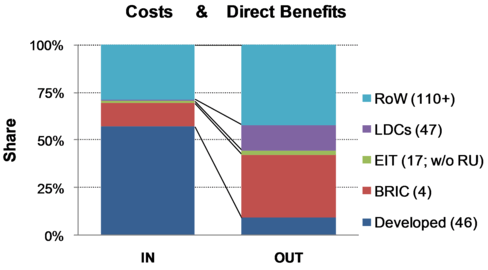
We clearly demonstrated how the hybrid mechanism can deliver on the UNFCCC principles, especially on the principle of common but differentiated responsibilities and respective capabilities. This focus had been requested by several parties.
The detail of the side event are:
Bunker fuel emissions, adaptation funding and technology transformation
on Thursday 12 June 2008, 18:00-20:00 hours
at the Ministry of Transport, Bonn, Room METRO
- Event flyer
- IMERS: a fair, hybrid scheme to mitigate emissions from international maritime transport that simultaneously provides innovative financing for adaptation and technology. Principles, costs & benefits, implementation & regulatory aspects, as well as impacts on states & stakeholders will be discussed.
- Increase momentum for an equitable and affordable approach.
- The event has been officially reported by the Earth Negotiations Bulletin. It generated a significant interest and stimulated lively debates, as reported:
- shortest web version (selected event; with additional links)
- pdf version
 (1.9 MB; IMERS - pg. 2-3)
(1.9 MB; IMERS - pg. 2-3)
- web version of all events (with additional pictures)
Why it was important?
- First international proposition that delivers on the 4 building blocks of the Bali Roadmap
- It does so at a scale of $4bn for mitigation, $4bn for adaptation, $2bn for technology
- Already discussed within the IMO and the UNFCCC
- The goal was to shape and increase momentum for a fair solution before 2012
Presentations and 3 debates were focused on
- How to differentiate responsibilities within a global scheme for shipping?
- Key design principles for an equitable and cost-efficient scheme:
- Mitigation & adaptation equally important (funding 50:50)
- Adaptation funding for developing countries only, of which 30% for LDCs (Least Developed Countries)
- Technology fund to accelerate innovation and technology transfer
- Long-term emission reduction goal
- Supra-national implementation
- Mitigation & adaptation equally important (funding 50:50)
- International Maritime Emission Reduction Scheme (IMERS):
- Why hybrid?
- Costs & benefits for different countries and stakeholders
- Implementation and regulatory aspects
- Why hybrid?
- Rapid progress and remaining obstacles:
- Multilateral status
- Time to accelerate
- Multilateral status
Presentation from the event is now available ![]() (0.8 Mb).
(0.8 Mb).
The event has been organised in cooperation with the Oxford Institute for Energy Studies.
- Log in to post comments
@ London: MEPC 58, GHG progress
The deadlock on addressing GHG emissions from shipping through market-based instruments has not been resolved at the IMO MEPC 58th session, London, UK, 06 - 10 October 2008.
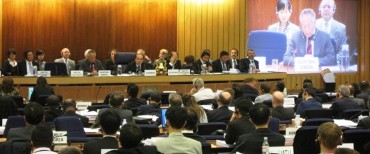
The new creative proposal to reconcile both Global and Differentiated approaches:
- Global (as per the IMO), and
- Differentiated (as per the UNFCCC)
Global but Differentiated is viable
Importantly, informal consultations with over 20 representations have proved that a Global but Differentiated Principle and Policy could indeed resolve the deadlock.
Essentially, the deadlock is caused by developed countries proposing only global uniform approaches when developing countries require a differentiated approach (as per the UNFCCC principle of common but differentiated responsibilities and respective capabilities, CBDR).
These two can be reconciled through an entirely new thinking. The old segmentation by flags, countries, routes and so on, is replaced with global destinations. In the current climate change regime the destinations are: Annex I and non-Annex I countries. See the GbD Principle and Policy.
Side Event
The side event was entitled Impacts of market-based instruments & The search for a global but differentiated policy. Presentation is now available ![]() (0.3 Mb). Viability of creating a global but differentiated market-based instrument for international shipping was debated and confirmed.
(0.3 Mb). Viability of creating a global but differentiated market-based instrument for international shipping was debated and confirmed.
The event has been organised by WWF UK to expand on the submission MEPC 58/4/39 ![]() (0.2Mb), and to provide an opportunity for a debate.
(0.2Mb), and to provide an opportunity for a debate.
Further Documents
- Global but Differentiated Principle and Policy, v.1.2

- IMERS - A differentiated scheme for CO2 emissions
 (a background case & summary for MEPC 58).
(a background case & summary for MEPC 58).
@ Brussels - Climate Justice
Treating international emissions (from shipping & aviation) as global and aggregating funding for adaptation & technology is seen as a major opportunity for the Copenhagen Agreement.
This was the result from the online consultation at the recent conference on Global Contract based on Climate Justice in the European Parliament.
In the category of policies for the industrialized nations the two most important suggestions voted on by participants were:
- Join a global environmental agreement and promote technology transfer. Finance R&D in clean technologies and renewables.
- Treat international emissions (shipping, aviation) as GLOBAL and aggregate funding for adaptation & technology.
- funding for adaptation and
- addressing emissions from international bunkers
This has also been introduced in the Background Paper for the conference.
The concluding Memorandum is available ![]() (0.6MB).
(0.6MB).
@ Poznan: a breakthrough?
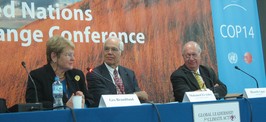 The potential of the IMERS scheme to generate $billions of financing for climate adaptation annually was officially presented and actively discussed at the Poznan Climate Change Conference, 1-12 December 2008. This included a high level roundtable opened by two UN Secretary General Special Envoys on Climate Change: Gro Brundtland and Ricardo Lagos.
The potential of the IMERS scheme to generate $billions of financing for climate adaptation annually was officially presented and actively discussed at the Poznan Climate Change Conference, 1-12 December 2008. This included a high level roundtable opened by two UN Secretary General Special Envoys on Climate Change: Gro Brundtland and Ricardo Lagos.
How to deliver special debate took place on 9th Dec (Message from the Event ![]() )
)
The dedicated official event was focused on CBDR:
Common but Differentiated Responsibilities in International Transport
Generating $billions for climate change action
Message & Summary from the Event ![]()
Presentation ![]() (0.4 Mb)
(0.4 Mb)
Event flyer ![]()
For more details, see a 4-page description, entitled:
Tackling climate change through a differentiated levy on marine haulage/shipping fuels ![]() .
.
The conclusion from the event and the proposed next steps were presented by Dr Andre Stochniol at the:
High level roundtable on climate technology and finance
organized by the GLCA on 10 Dec 2008
(the Global Leadership for Climate Action is a joint initiative of the United Nations Foundation and the Club of Madrid)
The roundtable brought together 20 leaders from both the public and private sectors. It included
- Ricardo Lagos, President of the Club of Madrid, co-chair of the GLCA, former President of Chile, UN Secretary General Special Envoy on Climate Change,
- Gro Brundtland, former Prime Minister of Norway, UN Secretary General Special Envoy on Climate Change,
- Dr. Mohamed El-Ashry, Former CEO and Chairman of the Global Environment Facility,
Subsequently, IMERS proposal was presented at the dinner of the United Nations Foundation.
We are very glad with the support obtained from the international leaders both at the above events, and during informal consultations in Poznan. These will significantly increase the momentum for action in the coming weeks and months.
Our main event has been organised in cooperation with the European Federation for Transport and Environment (T&E).
Support and Visibility at COP 14
- IMERS has been reviewed and/or proposed in many reports prepared for the conference, including:
- UNFCCC official update on Investment and financial flows to address climate change; FCCC/TP/2008/7
 (0.6MB); a shorter press summary is available as Fact sheet: Financing responses to climate change
(0.6MB); a shorter press summary is available as Fact sheet: Financing responses to climate change  (0.3MB);
(0.3MB);
- Innovative Carbon-Based Funding for Adaptation
 (0.7MB), a briefing paper by the OECD for the 11th Meeting of the Africa Partnership Forum; the most recent common but differentiated version of IMERS is described; other proposals are also described;
(0.7MB), a briefing paper by the OECD for the 11th Meeting of the Africa Partnership Forum; the most recent common but differentiated version of IMERS is described; other proposals are also described; - Linking Emissions Trading Schemes for International Aviation and Maritime Emissions
 in a comprehensive research by Climate Strategies on Linkages among Emissions Trading Schemes; the most recent GbD version of IMERS is described;
in a comprehensive research by Climate Strategies on Linkages among Emissions Trading Schemes; the most recent GbD version of IMERS is described;
- Turning Carbon into Gold
 (0.4MB), a briefing paper by OXFAM on "How the international community can finance climate change adaptation without breaking the bank"; written by Heather K. Coleman in collaboration with David Waskow;
(0.4MB), a briefing paper by OXFAM on "How the international community can finance climate change adaptation without breaking the bank"; written by Heather K. Coleman in collaboration with David Waskow;
- International Shipping in a post-2012 climate deal
 (0.2MB), a background paper, Global Climate Policy, by WWF, by Peter Lockley, WWF UK;
(0.2MB), a background paper, Global Climate Policy, by WWF, by Peter Lockley, WWF UK;
- Adaptation under the UNFCCC: The road from Bonn to Poznan
 (0.9MB), a briefing paper by Germanwatch, authored by Sven Harmeling;
(0.9MB), a briefing paper by Germanwatch, authored by Sven Harmeling;
- Negotiations on additional investment and financial flows to address climate change in developing countries
 (0.4MB), by UNDP, authored by Erik Haites.
(0.4MB), by UNDP, authored by Erik Haites.
- UNFCCC official update on Investment and financial flows to address climate change; FCCC/TP/2008/7
@ Geneva: UNCTAD Expert Meeting
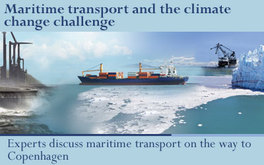 IMERS was thoroughly debated at the UNCTAD expert meeting on Maritime Transport and the Climate Change Challenge, in Geneva, 16 - 18 February. Our formal submission
IMERS was thoroughly debated at the UNCTAD expert meeting on Maritime Transport and the Climate Change Challenge, in Geneva, 16 - 18 February. Our formal submission ![]() (0.2 Mb) and the presentation
(0.2 Mb) and the presentation ![]() (0.3 Mb) were entitled:
(0.3 Mb) were entitled:
- A levy on fuel for international shipping, which differentiates responsibilities between developed and developing countries
IMERS solution was very well received by experts from both developing and developed countries. Several experts described it as a concrete proposal to bridge the gap between the CBDR principle (common but differentiated responsibilities) and the need for a global regime for shipping emissions. Some experts called for extra research.
Another perspective of the discussions in Geneva was that the scheme would contribute to increased trade and development for developing countries. This would be achieved by reducing the disproportionally high cost of transport typical for developing countries. The greatest short-term benefits are likely to be achieved by directing some of the funding raised by the scheme to trade facilitation, as shipping efficiencies has reached something of a plateau. Considering that such funding would pull behind several times more financing from the public and private sector significant improvements would be achieved. In short, proposed climate policy would lead to green economic growth.
It has also been pointed out that the imperative to address shipping emissions is already present in at least 14 separate paragraphs of the UNFCCC assembly paper on the Bali Action Plan (FCCC/AWGLCA/2008/16/Rev.1). Half of these refer to a levy on maritime transport (shipping fuel/marine haulage). These paragraphs reflect proposals by different states and organizations. They are: 23 (c )(iii), 26(f), 65(o), 68 (c), 72(d), 72(f), 87(a), 87(b), 96, 154(a), 155 (e), 172(d)(vi), 176(e), 178(a). Our view was that a state submission on the differentiated levy is essential to both the UNFCCC and the IMO multilateral processes (as the next IMO MEPC meeting that could consider such a proposal is after the draft of the Copenhagen Protocol/outcome is needed).
The details of the meeting are available from UNCTAD, including a background paper.
The meeting's records are available:
- Report of the Meeting
 (0.3 Mb)
(0.3 Mb)
- Papers and Presentations
- Recordings of the Presentations (audio; by day)
The meeting and IMERS have been reported in several publications, including:
- Fairplay (subscription), Fuel levy aired in Geneva
- Bridges Trade BioRes, Switzerland, IMO, UNFCCC Must Work Together to Tackle Maritime Transport Emissions: Experts
- Sustainable Shipping News, Lack of consensus delaying carbon cuts
- Le Monde, France, Le transport maritime explore des pistes pour réduire ses émissions de CO2 (in French)
- Bridges Weekly Trade News Digest, Tackling Shipping Emissions Requires Greater International Co-operation: Experts
@ Bonn 2009
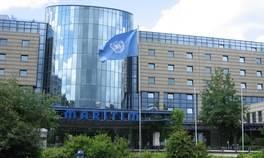 Our differentiated levy to finance climate change action was supported at the side event on day 1 of the Bonn Climate Change Talks - June 2009, entitled: Equitable Financing & Reducing Emissions from International Transport. Event flyer
Our differentiated levy to finance climate change action was supported at the side event on day 1 of the Bonn Climate Change Talks - June 2009, entitled: Equitable Financing & Reducing Emissions from International Transport. Event flyer ![]() | Fact Sheet
| Fact Sheet ![]() | Presentation
| Presentation ![]() .
.
Following opposition of major developing countries to uniform levies, we suggest to modify paragraph 173d of the LCA negotiating text ![]() to:
to:
A market-driven levy on emissions from international maritime transport applicable to ships carrying goods to developed countries (effectively).
- Event flyer
- The side event was dedicated to technically sound and politically acceptable levies on emissions from international aviation and maritime transport. Applied worldwide, collected centrally, they would raise $10bn+ annually for climate adaptation, REDD+, and technology.
- Galvanize the negotiations on levies for international transport.
- Fact Sheet
- There are two problems:
- Current mechanisms to finance climate change adaptation in developing countries are inadequate, both in scale and design.
- International shipping CO2 emissions are outside of the Kyoto Protocol, yet they are: significant and growing, double aviation emissions, global and complex.
- As the solution, a global market-based instrument for shipping is proposed. This can catalyze global cooperation and solve both these problems.
- The event has been recognized and reported by the Earth Negotiations Bulletin.
- shorter pdf version
 (0.2 MB), page 4;
(0.2 MB), page 4;
- web version with additional pictures.
The reports from the selected events held on 1 June are available:
To read on progress on the Bonn talks visit IISD Reporting Services.
Why the event was Important?
- Levies are proposed for negotiations within the AWG-LCA (paragraphs 36, and 173d)
- Shipping levy, which recognizes national circumstances, is viable
- As a result a draft negotiation text has been created
Presentation and Debate were Focused on
- How to pragmatically recognize national circumstances within a global scheme
- How to distribute financing from international levies
- International Maritime Emission Reduction Scheme
- How to galvanize the negotiations on equitable levies for international transport
Speaker and Panellists
- Andre Stochniol, IMERS (speaker)
- Henry Derwent, IETA
- Jake Schmidt, NRDC, USA
No net incidence at Bonn
 The Rebate Mechanism (RM) proposal gained further support at a side event at the Bonn Climate Change Talks entitled: "Ensuring no net incidence on developing countries from carbon pricing of international transport", held on 8 June 2011. See:
The Rebate Mechanism (RM) proposal gained further support at a side event at the Bonn Climate Change Talks entitled: "Ensuring no net incidence on developing countries from carbon pricing of international transport", held on 8 June 2011. See:
Event flyer & RM keys ![]() | Optimal Rebate Key Study
| Optimal Rebate Key Study ![]() (0.6MB) | RM Presentation
(0.6MB) | RM Presentation ![]() (0.7MB) | RM Outline and keys (2-pager)
(0.7MB) | RM Outline and keys (2-pager) ![]() (0.3MB).
(0.3MB).
For recent discussions at the IMO see: GHG-WG 3 summary.
The debate was very good and covered technical details as well as ongoing negotiations on the matter.
You may wish to review the RM Presentation ![]() (0.7MB), read the Optimal Rebate Key Study
(0.7MB), read the Optimal Rebate Key Study ![]() (0.6 MB), grab the RM Outline and keys (2-pager)
(0.6 MB), grab the RM Outline and keys (2-pager) ![]() (0.3MB) or see the GHG-WG 3 summary.
(0.3MB) or see the GHG-WG 3 summary.
The Rebate and Attribution keys for nearly 200 countries are also available as handy 2-page summaries, in three languages:
Rebate Mechanism & COP16
 There was no outcome/decision relating to international aviation and maritime transport at COP16/CMP6 Conference at Cancun (see Cancun Agreements: AWG-LCA
There was no outcome/decision relating to international aviation and maritime transport at COP16/CMP6 Conference at Cancun (see Cancun Agreements: AWG-LCA ![]() and AWG-KP
and AWG-KP ![]() ).
).
The report of the High-Level Advisory Group on Climate Change Financing (AGF Report ![]() (1 MB)) was noted and the proposal for a separate financing review was removed (see AWG-LCA
(1 MB)) was noted and the proposal for a separate financing review was removed (see AWG-LCA ![]() ).
).
We held an official side event on our proposal for the Rebate Mechanism; Presentation ![]() (0.4 MB) and documents are available.
(0.4 MB) and documents are available.
Several influential Parties were supportive of global schemes for aviation/shipping with no net incidence on developing countries, as recommended in the AGF Report ![]() (1 MB) (detailed in the AGF paper on International Transport
(1 MB) (detailed in the AGF paper on International Transport ![]() ). Our rebate mechanism is described/endorsed in the paper.
). Our rebate mechanism is described/endorsed in the paper.
Below is our summary from Cancun.
Before Cancun
The United Nations Climate Change Conference (COP16/CMP6) was held from 29 November to 10 December 2010 in Cancun, Mexico.
In advance of the COP16/CMP 6 conference, both the International Civil Aviation Organization (ICAO) and the International Maritime Organization (IMO) worked hard to convince the international community that they were making good progress on pursuing the reduction or limitation of greenhouse gas (GHG) emissions from international aviation and maritime transport, respectively. Both argued that they should be entrusted with continuing their work, and should do so according to their global rules and provisions.
Both organizations have however failed thus far to reconcile the UNFCCC principles of equity and common but differentiated responsibilities (CBDR) - to be applied at the country-level - with uniform rules, that apply at the vessel/carrier-level.
Hopes related to the AGF report
Some NGOs and countries hoped that the report of the UN Secretary-General’s High-Level Advisory Group on Climate Change Financing (AGF Report ![]() (1 MB)) published 5 November 2010 would help to progress the negotiations on international transport in Cancun. The report recommended that any scheme generating revenue for climate action should have no net incidence on developing countries (i.e. zero cost burden). The report recommended putting a price on GHG emissions from international transport, with no net incidence on developing countries, thereby effectively endorsing a certain way of implementing CBDR in international transport. For shipping, the report highlighted a rebate mechanism for developing countries proposed in the IMO (detailed in the AGF technical report 2); for aviation it suggested that universal application may also be more appropriate, supported by compensation options for vulnerable least developed countries.
(1 MB)) published 5 November 2010 would help to progress the negotiations on international transport in Cancun. The report recommended that any scheme generating revenue for climate action should have no net incidence on developing countries (i.e. zero cost burden). The report recommended putting a price on GHG emissions from international transport, with no net incidence on developing countries, thereby effectively endorsing a certain way of implementing CBDR in international transport. For shipping, the report highlighted a rebate mechanism for developing countries proposed in the IMO (detailed in the AGF technical report 2); for aviation it suggested that universal application may also be more appropriate, supported by compensation options for vulnerable least developed countries.
What happened at Cancun
The general position of developed countries was to eliminate CBDR from a future regime for international transport, while the position of developing countries was the opposite: defend CBDR as the cornerstone of UNFCCC. Furthermore, many developing countries also argued that a uniform approach could constrain their trade and development, and could burden them with additional costs. Overall, the negotiations under the mitigation agenda were highly contentious. The financing discussions never took place, as a relevant opportunity did not materialize.
No Outcome
There was no outcome on international transport at COP16/CMP6. There is no reference to international aviation and maritime transport in the Cancun Agreements (AWG-LCA ![]() and AWG-KP
and AWG-KP ![]() ).
).
Negotiations of the sectoral approaches, comprising agriculture and international transport, were highly contentious. Parties were unable to agree the framing paragraph for the sectoral approaches, in the LCA section 1 b(iv). In fact this prevented specific discussions on international transport, as Parties declined to discuss it until the framing paragraph was agreed. The key issue was whether the principle of common but differentiated responsibilities and respective capabilities (CBDR) is referred to in the framing paragraph, and thus applies to sectors, including international transport.
Relevant Events
UNFCCC Official Side Events
- The following were organized:
- ICAO and IMO: Emissions from international transport – global solutions for global industries
- International Air Transport Association (IATA): Aviation bunker fuels
- United Nations (UN): The report of the Secretary-General’s High-level Advisory Group on Climate Change Financing (AGF): discussing the key findings;
webcast available
- IMERS: Rebate Mechanism for Equitable Financing and Emission Reductions in International Transport
- Baltic and International Maritime Council (BIMCO): Shipping and combating climate change
IMERS side event
- For convenience materials from our/IMERS side event are referenced:
- Agenda - Rebate Mechanism (RM)

- RM Presentation
 (0.4 MB)
(0.4 MB)
- RM - IMO submissions - 1
 & 2
& 2  (in English)
(in English)
- RM - Mécanisme de remboursement - 1
 & 2
& 2  (in French)
(in French)
- RM - Mecanismo de reembolso - 1
 & 2
& 2  (in Spanish)
(in Spanish)
- WWF Position Paper on Bunker Finance
 (0.2 MB)
(0.2 MB)
Other events
- The following took place:
- Papua New Guinea and Carbon War Room: Operation ‘Rock the Boat’: the launch of www.shippingefficiency.org; webcast available
- UN Non-Governmental Liaison Service (UN-NGLS): Climate Finance – The Role of Public Sources (debate with the AGF deputies & Dr Stochniol on how the these sources can be reconciled with CBDR)
- International Centre for Trade and Sustainable Development (ICTSD): Bunker Fuels: On Course or Up in the Air? – Discussion (part of ICTSD Symposium; details on: www.ictsdclimate.org)
Future way out?
Given that the AGF Report was noted at the Cancun Agreements, and no separate financing review was mandated, approaches such as the rebate mechanism in shipping that would deliver zero net incidence on developing countries are gaining increased traction. They could break the deadlock on emission reductions from international transport, and simultaneously provide a predictable source of significant finance ($10bn+ annually).
Given our discussions with representatives from over 50 countries, we are cautiously optimistic regarding progress in international transport in 2011 (especially in shipping).
We are actively pushing for it, and are looking for financing support to make the progress a reality.
@ London: MEPC 59, and climate financing
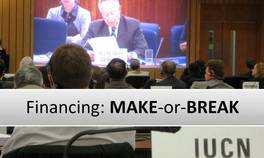 Financing of climate change action is make-or-break for the ongoing climate change negotiations. This view was expressed by the IUCN delegation at the IMO MEPC 59 session, London, UK, 13 - 17 July 2009. Suggestions for proactive steps were made in the IUCN statement
Financing of climate change action is make-or-break for the ongoing climate change negotiations. This view was expressed by the IUCN delegation at the IMO MEPC 59 session, London, UK, 13 - 17 July 2009. Suggestions for proactive steps were made in the IUCN statement ![]() , with specific references to paragraph 173 option 4 of the revised negotiating climate change text (for COP 15).
, with specific references to paragraph 173 option 4 of the revised negotiating climate change text (for COP 15).
In the key area of reducing GHG emission from shipping, the meeting issued some technical and operational measures.
The MEPC (Committee) noted that there was a general preference for the greater part of any funds generated by a market-based instrument under the auspices of IMO to be used for climate change purposes in developing countries through existing or new funding mechanisms under the UNFCCC or other international organizations.
However, the Committee was only able to agree a work plan for further consideration of market-based measures. For a more detailed summary see a section below.
Climate financing: make-or-break
The financing aspect of a potential levy on emissions from shipping, or a similar measure, is now being discussed at the UNFCCC. This track still offers hope for 2009, with the scheme potentially starting in 2013.
For instance, the IMERS approach has been recently reviewed and recommended by the African Group ![]() (0.3 MB). It was also the African Group who made a small but important adjustment to paragraph 173 option 4 of the revised negotiating text for COP 15
(0.3 MB). It was also the African Group who made a small but important adjustment to paragraph 173 option 4 of the revised negotiating text for COP 15 ![]() (2.8 MB). The words "for developed countries" were added to the option for levies on emissions from international aviation and maritime transport. The attribution of the revisions were made public only after the Bonn Climate Change Talks, in August.
(2.8 MB). The words "for developed countries" were added to the option for levies on emissions from international aviation and maritime transport. The attribution of the revisions were made public only after the Bonn Climate Change Talks, in August.
Simplified version of IMERS
Our recent informal discussions with negotiators from several developing countries have been successful. They also led to further improvements of the IMERS proposal. In a nutshell, the modified version will be much easier to implement by the maritime industry worldwide. It will be announced at the Bangkok Climate Change Talks (28 Sept - 09 Oct 2009).
MEPC 59 summary on Air Pollution (agenda 4)
Air Pollution was the major agenda item for MEPC 59 with 49 submissions, 11 information documents, and approximately a dozen submissions kept in abeyance from the previous sessions.
The discussions related to two areas: MARPOL Annex VI-related issues, and control of greenhouse gas (GHG) emissions from ships. Only the GHG details are described below.
GHG emissions from ships was the largest agenda item with well over 50 documents for consideration, and the description below is our humble attempt to capture the key points.
The work plan to identify and develop the mechanisms needed to achieve the limitation or reduction of CO2 emissions from international shipping was agreed at MEPC 55 in 2006. It spanned four sessions of MEPC, culminating at MEPC 59. A significant amount of time was allocated for the debate of the item with expectations of delivering a package of GHG control measures at this session. The need was high in the context of upcoming Conference of Parties to the climate convention in Copenhagen, in December 2009 (COP 15). However, for many insiders it was clear, even before the session, that application of the potential measures might be impossible to agree, especially in relation to market-based measures.
Global GHG measures once again turned out to be a very polarized issue in the plenary session, even though general statements were withheld. Essentially, the developed countries argued for globally uniform and compulsory measures. In contrast, developing countries called for differentiated and/or voluntary measures. Specifically, the developing countries stressed the need to comply with the principles of the UNFCCC, including the principle of common but differentiated responsibilities and respective capabilities (referred by many as the CBDR principle). The Committee therefore agreed to consider technical documents by a GHG working group, defer the debate on the application of GHG instruments to the next session and have a plenary in-depth debate on market-based measures. The Committee also agreed to create a work plan for further consideration of market-based measures.
- The outcome of MEPC 59 does not include any compulsory measures, and as such can be seen as limited in its effectiveness. The Committee, inter alia:
- Agreed to circulate two interim guidelines for Energy Efficiency Design Index (EEDI) for new ships (method of calculation, and voluntary verification);
- Agreed to circulate the Guidance on the development of a Ship Energy Efficiency Management Plan (SEEMP) for new and existing ships, as well as guidelines for voluntary use of the Ship Energy Efficiency Operational Index (EEOI) for new and existing ships;
- Agreed a work plan (J10 paper) for further consideration of market-based measures at the next biennium of the IMO, taking into account relevant outcomes of COP 15 (effectively from MEPC 60, in March 2010 onwards).
EEDI, SEEMP, and EEOI are intended to be used for trial purposes. They are to be refined at the MEPC 60 in March 2010, with a view to facilitate decision on their scope of application and enactment.
For the market-based measures, the Committee also noted that there was a general preference for the greater part of any funds generated through such measures to be used for climate change purposes in developing countries through existing or new funding mechanisms under the UNFCCC or another international organization.
The outcome of the MEPC on GHG emission from ships will be reported to COP 15, which will consider a successor instrument to the Kyoto Protocol to the UNFCCC.
The session also approved the results of the Second IMO study on GHG emissions from ships (MEPC 59/INF.10). The study, shows that in 2007 shipping consumed 333 million tons of fuel and emitted roughly 1 Gigaton of CO2 . The corresponding numbers for international shipping are 280 and 843 millions respectively. The contribution of international shipping to global CO2 emissions is estimated as 2.7%. Estimates of fuel consumption of shipping for 2050 range from 400 - 810 millions tons with corresponding CO2 emission about three times these numbers, assuming no reduction measures are in place. The main conclusion from the report is that substantial reduction of GHG emissions from ships are possible. Market based instruments (MBIs), technical and operational measures should contribute but the largest and most efficient reductions are expected from a compulsory MBI (or instruments).
@ Bangkok & Singapore
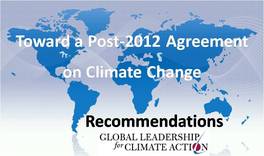 The latest version of IMERS was well received by many delegations at the UNFCCC climate change negotiations (28 Sept - 09 Oct, 2009). Three weeks later it was disclosed publicly in Singapore
The latest version of IMERS was well received by many delegations at the UNFCCC climate change negotiations (28 Sept - 09 Oct, 2009). Three weeks later it was disclosed publicly in Singapore ![]() (0.4 MB).
(0.4 MB).
Our proposal has also been included in recommendations for negotiators distributed in Bangkok. The recommendations came from a task force comprising former heads of state, leaders from government, business and civil society in a report Toward a Post-2012 Agreement on Climate Change: Recommendations ![]() (1 MB).
(1 MB).
The recommendations are from the Global Leadership for Climate Action (GLCA), a partnership of the Club of Madrid and the United Nations Foundation (UNF). The report consolidates the key GLCA recommendations for all areas of the Bali Action Plan. It includes financing recommendations from the comprehensive adaptation report, distributed to negotiators in June 2009.
Progress in Bangkok
The recent top-down simplification of IMERS, that made the proposal even more attractive, has been discussed "behind closed doors". The proposal has gained more traction with several key delegations.
Public disclosure in Singapore
The details of the new version were disclosed at the Carbon Forum Asia, Singapore, 26 - 27 October.
In a nutshell:
- a market-based levy would apply to all ships engaged in international transport,
- each developing country would be entitled to a refund, in proportion to its share of worldwide imports,
- a country could forego the refund,
- 100% of revenue raised, estimated at $10bn+ annually, would go to climate change action.
A short presentation of the refund proposal is available
@ Barcelona: A breakthrough
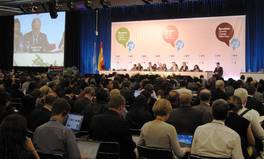 The novel, refund version of IMERS has been tabled at the Barcelona Climate Change Talks (2 - 6 Nov, 2009)!
The novel, refund version of IMERS has been tabled at the Barcelona Climate Change Talks (2 - 6 Nov, 2009)!
The proposal Innovative Financing and International Maritime Emission Reduction Scheme has been submitted
.
A layman 1-page outline is available, entitled: 2 for 1: Financing climate action and Cutting shipping emissions ![]() (0.2 MB).
(0.2 MB).
Progress in Barcelona
The proposal has been submitted under the track known as 1b (iv), called:
- Enhanced action on mitigation and its associated means of implementation;
Subgroup on paragraph 1 (b) (iv) of the Bali Action Plan
(cooperative sectoral approaches and sector specific actions).
The proposal is linked to the provision of financial resources, namely to paragraphs referring to:
"Levies on emissions from international maritime transport for developed countries ...", and similar.
See the latest: Non-paper No. 54, and Non-paper No. 34.
In a nutshell, the submission proposes to:
- Implement a market-based levy on emissions from international maritime transport which differentiates between responsibilities [and capabilities] of developed and developing countries. Such levy would apply globally.
The scheme would raise circa $10bn+ annually for action on climate change in developing countries. At the same time, it would reduce emissions, and generate benefits to end customers through reduced costs of transport. A short presentation is available
The submission has been made possible thanks to leadership of Transport and Environment decision makers in Nigeria, and Liberia (both developing countries). It has been championed by the Nigerian Maritime Administration and Safety Agency (NIMASA) since negotiations in Bangkok, 2009.
@ Copenhagen
 The United Nations Climate Change Conference 2009 (COP 15) did not succeed in addressing emissions from international aviation and maritime transport.
The United Nations Climate Change Conference 2009 (COP 15) did not succeed in addressing emissions from international aviation and maritime transport.
To contribute to the ongoing negotiations the proposal for Innovative Financing and IMERS was clarified and debated at the official COP15 side event, 9 Dec, 2009, Bella Center, Copenhagen.
Presentation is available ![]() (0.4 MB).
(0.4 MB).
The IMERS proposal has also been discussed in other relevant side events and reviewed in several publications launched at COP 15 (such as the comprehensive The Little Climate Finance Book, available in English, French, Spanish, and Portuguese).
- The proposal is ticking off the negotiation boxes:
- It complies with climate Convention principles (including the CBDR)
- It's global
- It's simple but not simplistic
- It puts a carbon price on shipping emissions, equal to the global carbon price (i.e. shipping would pay exactly the same price as any other industry; no more, no less)
- It's easily affordable (as shipping is an energy efficient mode of transport)
- It's win-win: good for environment and good for shipping/trade
- It would deliver ambitious emission reductions efficiently, while raising $billions annually for action on climate change
- It's flexible to accommodate national circumstances, including of the USA
- It can be implemented from 2013
- It does not require setting a global cap on shipping emissions
A layman 1-page outline is available, entitled: 2 for 1: Financing climate action and Cutting shipping emissions
Unfortunately, the actual negotiation process that took place at COP15 was not conducive for any concrete financing proposals. It became however even clearer that innovative/alternative off-budget financing will be essential to deliver predictable financing for climate action from 2013 onwards.
Progress in Barcelona
The proposal has been submitted under the track known as 1b (iv), called:
- Enhanced action on mitigation and its associated means of implementation;
Subgroup on paragraph 1 (b) (iv) of the Bali Action Plan
(cooperative sectoral approaches and sector specific actions).
The proposal is linked to the provision of financial resources, namely to paragraphs referring to:
"Levies on emissions from international maritime transport for developed countries ...", and similar.
See the latest: Non-paper No. 54, and Non-paper No. 34.
In a nutshell, the submission proposes to:
- Implement a market-based levy on emissions from international maritime transport which differentiates between responsibilities [and capabilities] of developed and developing countries. Such levy would apply globally.
The scheme would raise circa $10bn+ annually for action on climate change in developing countries. At the same time, it would reduce emissions, and generate benefits to end customers through reduced costs of transport. A short presentation is available
Rebate Mechanism & MEPC 60
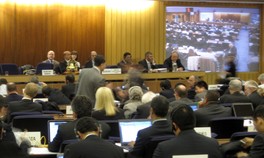 Some progress on addressing greenhouse gas (GHG) emissions from ships was made at the IMO MEPC 60 session. IUCN submitted a proposal for an innovative rebate mechanism, based on our work. The proposal (MEPC 60/4/55)
Some progress on addressing greenhouse gas (GHG) emissions from ships was made at the IMO MEPC 60 session. IUCN submitted a proposal for an innovative rebate mechanism, based on our work. The proposal (MEPC 60/4/55) ![]() , which aims to reconcile the principles of the UNFCCC and IMO, was welcomed but not debated. MEPC agreed to establish an Expert Group on Market Based Measures (MBM-EG) to study it, among other proposals.
, which aims to reconcile the principles of the UNFCCC and IMO, was welcomed but not debated. MEPC agreed to establish an Expert Group on Market Based Measures (MBM-EG) to study it, among other proposals.
The Copenhagen Climate Change Conference in Dec 2009 (COP 15) did not resolve any issues on GHG emissions for the IMO. Therefore, as before at MEPC 58 and MEPC 59, they were contentious at the 60th session of the IMO's Marine Environment Protection Committee (MEPC 60), which took place in London, UK, from 22 - 26 March 2010.
The most contentious issue was whether or not to explicitly take the CBDR principle into account, especially while considering market-based measures (MBM), or instruments (CBDR refers to common but differentiated responsibilities and respective capabilities, enshrined in UNFCCC).
The other contentious issues were whether the measures to reduce GHG emissions from ships should be mandatory, whether the technical measures should be implemented through an amendment of MARPOL convention's Annex VI, and whether the proposed measures were mature enough. In general, the positions of developed and developing countries were opposed on all these issues. Another potentially dividing issue of setting a global emission reduction target for GHG emissions from international shipping was not debated, albeit a couple of papers were shortly outlined.
Some progress was made in the further development of the Energy Efficiency Design Index (EEDI) and related items, but more needs to be done. All the other important issues, including MBM such as the one proposed by IUCN, still need in depth discussions.
To make progress on these issues, MEPC:
- established an intersessional Working Group, specifically on issues concerning ship size, target dates and reduction rate in relation to EEDI;
- agreed to establish an Expert Group on MBM (MBM-EG) to undertake a feasibility study and impact assessment of ten relevant proposals submitted. The proposals include emissions trading, a fuel levy or contribution, and the rebate mechanism (IUCN);
- agreed that the debate on the reduction targets was a vital part of GHG work, and invited further input to the next session.
Additional detail on progress achieved at MEPC 60 is available from the IMO.
Summary of the rebate mechanism for a market-based instrument for international shipping
Document MEPC 60/4/55 ![]() proposes a rebate mechanism for a market-based instrument (MBI) for international shipping in order to deliver on the UNFCCC principle of common but differentiated responsibilities and respective capabilities (CBDR). The rebate mechanism could ensure that developing countries are not disadvantaged by a yet to be decided MBI but rather benefit from it.
proposes a rebate mechanism for a market-based instrument (MBI) for international shipping in order to deliver on the UNFCCC principle of common but differentiated responsibilities and respective capabilities (CBDR). The rebate mechanism could ensure that developing countries are not disadvantaged by a yet to be decided MBI but rather benefit from it.
The proposed rebate mechanism can apply to any MBI for international shipping.
Also available are:
- MEPC 60/4/55 in French
 , Mécanisme de remboursement dans le cadre de l'instrument fondé sur le marché destiné aux transports maritimes internationaux
, Mécanisme de remboursement dans le cadre de l'instrument fondé sur le marché destiné aux transports maritimes internationaux
- MEPC 60/4/55 in Spanish
 , Mecanismo de reembolso para un instrumento de mercado para el transporte marítimo internacional
, Mecanismo de reembolso para un instrumento de mercado para el transporte marítimo internacional
- A short overview presentation (in English)

- Further details submitted to MEPC 61
Update on shipping emissions and climate financing outside of IMO
The financing aspect of a potential levy on emissions from shipping, or a similar MBI, is increasingly getting more attention. The high-level Advisory Group on Financing of Climate Change (AGF), established by the UN Secretary General considers it as one contributing option. Their goal is to identify sources of innovative financing to mobilize $100bn annually, from developed countries, by 2020. This is to fuflfill commitments incorporated in the Copenhagen Accord, 2009. The rebate mechanism would guarantee that the financing is from the developed countries only, as agreed.
In another development, Botswana in its recent UNFCCC submission reminded about relevant negotiations during COP 15. In short, the draft negotiating text anticipated using revenue raised from a shipping MBI (and aviation) for climate change action in developing countries.
Rebate Mechanism & MEPC 61
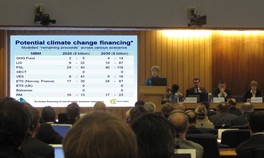 Further progress on reducing greenhouse gas (GHG) emissions from ships was made at the IMO MEPC 61 session. MEPC received a comprehensive 300+ page report
Further progress on reducing greenhouse gas (GHG) emissions from ships was made at the IMO MEPC 61 session. MEPC received a comprehensive 300+ page report ![]() (2.5MB) and presentation
(2.5MB) and presentation ![]() (2MB) from the Expert Group on Market-based Measures (MBM-EG).
(2MB) from the Expert Group on Market-based Measures (MBM-EG).
The group studied the various MBM proposals, including the Rebate Mechanism (RM) ![]() . Further details on RM
. Further details on RM ![]() were submitted, based on our work.
were submitted, based on our work.
Two main RM options were described in more details:
- add-on option (which can apply to any revenue raising MBM)
- integrated option (aka IMERS proposal, 3rd generation)
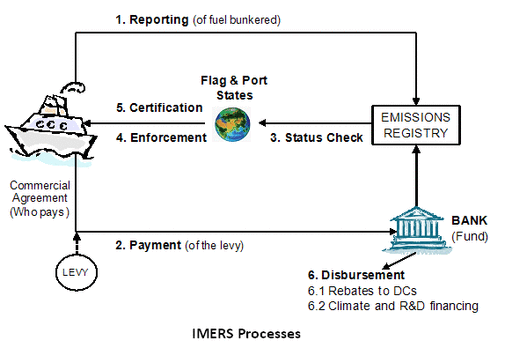
For more details see the document, available in 3 languages:
- MEPC 61/5/33 in English
 , Further information on a rebate mechanism for a market-based measure for international shipping
, Further information on a rebate mechanism for a market-based measure for international shipping
- MEPC 61/5/33 in French
 , Renseignements complémentaires sur un mécanisme de remboursement dans le cadre d'une mesure fondée sur le marché destinée aux transports maritimes internationaux
, Renseignements complémentaires sur un mécanisme de remboursement dans le cadre d'une mesure fondée sur le marché destinée aux transports maritimes internationaux
- MEPC 61/5/33 in Spanish
 , Información adicional sobre un mecanismo de reembolso para una medida de mercado para el transporte marítimo internacional
, Información adicional sobre un mecanismo de reembolso para una medida de mercado para el transporte marítimo internacional
- Base proposal is also available in these languages.
Summary of the GHG-related discussions
The ongoing UNFCCC negotiations have not resolved any political issues on shipping GHG emissions for the IMO yet, nor has the MBM-EG. Therefore, the discussions on addressing GHG were contentious and time consuming at the 61st session of the IMO's Marine Environment Protection Committe (MEPC 61), which took place in London, UK, from 27 Sept - 1 Oct 2010.
The most contentious issue, as before at the previous sessions MEPC 58, MEPC 59, and MEPC 60, was whether or not to explicitly take the CBDR principle into account (CBDR refers to common but differentiated responsibilities and respective capabilities, enshrined in the UNFCCC).
There was no majority view on which MBMs should be developed further, and certain concerns were raised regarding impact on world trade, and similar. An intersessional meeting in March 2011 will consider the MBMs further.
To make progress on these issues, MEPC:
- established an intersessional meeting in March/April 2011, tasked with providing an opinion on the compelling need and purpose of MBMs and further evaluating them, including impact on international trade.
Non-MBM measures
The technical and operational GHG measures progressed as well. The contentious issues were whether such measures should be mandatory for all countries, whether text relating to capacity building and technology transfer should be a part of regulation, whether the proposed measures should be implemented through an amendment of MARPOL convention's Annex VI, and whether they were mature enough.
The proposed amendments to Annex VI of MARPOL are to be circulated to the Parties by the IMO Secretary General, for consideration of adoption at MEPC 62.
Setting a global emission reduction target for GHG emissions from international shipping was not debated, due to lack of time.
MEPC considered also speed reduction as a regulatory option. It agreed that speed would be addressed indirectly through the other measures, and therefore decided that no further investigation of speed reductions as a separate regulatory path was needed.
Official information on the progress achieved at MEPC 61 is available from the IMO.
RM & no net incidence at GHG-WG 3
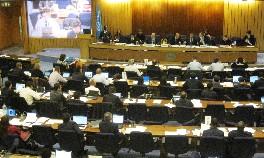 Some progress on reducing greenhouse gas (GHG) emissions from ships was made at the IMO Intersessional Meeting of the GHG Working Group (GHG-WG3). The concept of "no net incidence" through a Rebate Mechanism (RM)
Some progress on reducing greenhouse gas (GHG) emissions from ships was made at the IMO Intersessional Meeting of the GHG Working Group (GHG-WG3). The concept of "no net incidence" through a Rebate Mechanism (RM) ![]() (0.5MB) generated a considerable interest. An optimal rebate key
(0.5MB) generated a considerable interest. An optimal rebate key ![]() (0.2MB) was proposed, with values for all countries. A systematic analysis submitted
(0.2MB) was proposed, with values for all countries. A systematic analysis submitted ![]() , favoured a global application with a RM to ensure no net incidence on developing countries and with revenue used for climate change action.
, favoured a global application with a RM to ensure no net incidence on developing countries and with revenue used for climate change action.
The third Intersessional Meeting of the Working Group on GHG emissions from ships was held in London from 29 March to 1 April 2011. At this meeting the concept of "no net incidence" on developing countries (particularly the most vulnerable) from carbon pricing of international transport generated considerable interest from a number of developed and developing States and observer organizations. Inter alia (for more see the session's report, document MEPC 62/5/1):
[...]
A number of delegations expressed interest in the RM proposal and supported its further development and consideration either as an integral or add-on element to a future MBM for international shipping under IMO
Regarding details, two session documents contained new results contributed on the topic. The document GHG-WG 3/3/11 ![]() (0.5MB), entitled "Towards an optimal rebate key for a global maritime MBM", was submitted by the WWF, based on a study by Dr Andre Stochniol.
(0.5MB), entitled "Towards an optimal rebate key for a global maritime MBM", was submitted by the WWF, based on a study by Dr Andre Stochniol.
- It concluded as follows:
- The annexed Study demonstrates that it is feasible to calculate a suitable proxy for incidence from a global maritime MBM, such as a levy or an emission trading scheme, on different countries. Thus, if so decided, it is feasible to design and implement a global maritime MBM with "no net incidence" on developing countries, by ensuring these countries are compensated for the cost incurred from the global maritime MBM, through a rebate approach.
- It concluded as follows:
- There are various proposals for differentiated application of an MBM for international shipping, but all raise concerns over data, enforcement or competitive distortion. A global mechanism avoids these concerns and could respect the principle of CBDR if it resulted in no net incidence on developing countries. A rebate mechanism could be applied to any revenue-raising MBM, is technically feasible, and if correctly designed, could ensure no net incidence on developing countries.
Key Results from the study on optimal rebate key
Rebate and attribution keys
A country's share of value of imports from non-adjacent countries, adjusted for trade patterns in Europe and in Latin America, is found to be the optimal attribution key to calculate incidence on the country from a global MBM, for all countries irrespective of their trade distances. The key provides the best estimates of the incidence given readily available and reliable data.
According to the calculations presented, in 2007 circa 70% of global trade by value was transported by sea and air. Of this, developed and developing countries accounted for circa 60% and 40% respectively. Thus, the estimate of total incidence on developing countries from a global maritime MBM is circa 40% of its global costs. This is more than the 30% estimate based on value share of imports by all modes of transport (used before in various reports). However, given that some developing countries may pursue the option of foregoing all or part of their rebates, it is still viable to continue to use the 30% as an illustrative integration condition for a global maritime MBM with "no net incidence" on developing countries.
The summary of the proposed rebate keys, based on percentage of global costs of the MBM, is shown below.

Rebate keys for over 150 developing countries and attribution keys for developed countries are calculated and presented in the annex to the GHG-WG 3/3/11 document (the rebate keys are illustrated below).
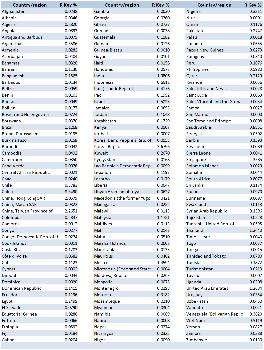
Under the RM proposal, the attribution keys are proposed to calculate and credit the amount of financing
raised through the MBM from each developed country (these are illustrated below)
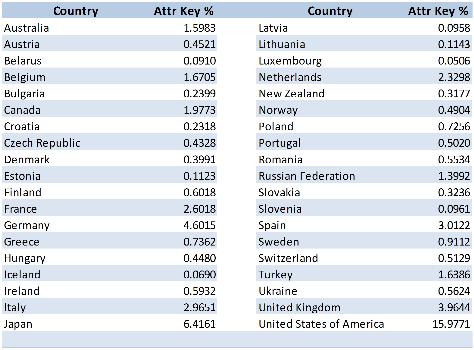
Trade-weighted distances
Comprehensive justification for the calculations are made in the study, including trade-weighted distances for countries, as illustrated below.
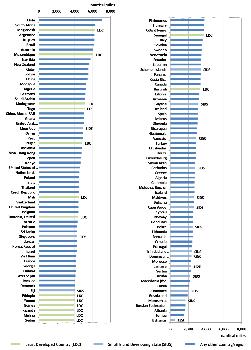
Integration with other Market-Based Measures, or Mechanisms (MBM)
Conditions to integrate the optimal rebate key with the MBM proposals under consideration at the IMO are provided as well. These are summarized on the figure below (updated to reflect submissions to and discussions at the Intersessional Meeting).
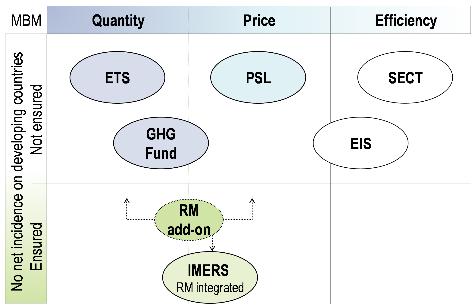
MBM legend:
EIS Efficiency Incentive Scheme
ETS Emission Trading System
GHG Fund International Fund for GHG emissions from ships
PSL Port State Levy
RM Rebate Mechanism; add-on, and integrated (IMERS)
SECT Ship Efficiency Credit Trading
Summary for the session
For a short summary from the session relating to the "no net incidence" see the WWF document MEPC 62/5/14.
Official information on the overall progress achieved during the Intersessional Meeting is available from the IMO.
RM at Panama, and beyond
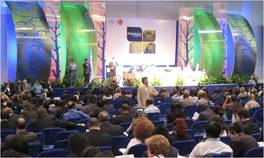 The Rebate Mechanism (RM) to enable pricing of international emissions was debated further at a side event at the Panama Climate Change Talks; see:
The Rebate Mechanism (RM) to enable pricing of international emissions was debated further at a side event at the Panama Climate Change Talks; see:
RM Presentation ![]() (0.8MB) | RM Outline and keys (2-pager)
(0.8MB) | RM Outline and keys (2-pager) ![]() (0.3MB).
(0.3MB).
The debate and discussions that followed, contributed to negotiations of relevant text options for the Durban conference in Nov/Dec 2011 (see the conclusion slide).
The site event, entitled: "Ensuring no net incidence on developing countries from carbon pricing of international transport", was held on 2 October 2011.
The debate was very good and covered technical details as well as ongoing negotiations on the matter (namely how to reconcile the UNFCCC principles with a global approach to address emissions from international transport, and obtain progress at the Durban conference).
You may wish to review the RM Presentation ![]() (0.8MB; it includes links to various additional analysis), or read a short RM 2-pager, that also includes the attribution and the rebate keys for various countries, available in English, French and Spanish:
(0.8MB; it includes links to various additional analysis), or read a short RM 2-pager, that also includes the attribution and the rebate keys for various countries, available in English, French and Spanish:
- Rebate Mechanism (2-pager in English)
 ( Securing additional climate financing by Ensuring No Net Incidence on Developing Countries from Carbon Pricing of International Transport)
( Securing additional climate financing by Ensuring No Net Incidence on Developing Countries from Carbon Pricing of International Transport)
- Mécanisme de compensation
 (Sécuriser des financements climat additionnels Sécuriser une tarification carbone des transports international avec zéro incidence nette sur les pays en développement)
(Sécuriser des financements climat additionnels Sécuriser une tarification carbone des transports international avec zéro incidence nette sur les pays en développement)
- El mecanismo de reembolso
 (Cómo obtener financiación adicional para hacer frente al cambio climático mediante un mecanismo para garantizar que no haya incidencia neta para los países en desarrollo como resultado de la tarificación de las emisiones de carbono del transporte internacional)
(Cómo obtener financiación adicional para hacer frente al cambio climático mediante un mecanismo para garantizar que no haya incidencia neta para los países en desarrollo como resultado de la tarificación de las emisiones de carbono del transporte internacional)
New analytical material
Furthermore, the following analysis and briefing notes are made publicly available:
- Optimal Rebate Key Study
 (0.6 MB).
(0.6 MB).
- Impact on Trade

- Impacts on Developing Countries

- Impacts on food prices

- Flexibility of maritime MBMs

- Analysis of trade impacts on Bangladesh and South Africa
 (imports and exports)
(imports and exports)
Negotiating text for Durban
Links will be added shortly.
Outcome of G20 meeting in Cannes
Not much, but the WB-IMF-OECD-RDBs report on Mobilizing Climate Finance ![]() (0.9MB) is mentioned and finance ministers are invited to continue working on the issue of climate finance.
(0.9MB) is mentioned and finance ministers are invited to continue working on the issue of climate finance.
Recent discussion at the IMO
For the recent discussions at the IMO see: GHG-WG 3 summary, as the topic was not discussed at the IMO MEPC 62 meeting (as the focus was then on the adoption of the technical and operational measures to reduce GHG emissions from international shipping).
COP 17 & climate finance
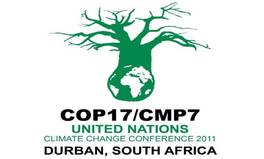 There was no material progress on addressing emissions from international aviation and maritime transport at the United Nations Climate Change Conference COP 17 / CMP 7 at Durban. The Parties only agreed to continued consideration of issues related to these emissions, and there was no direct reference to innovative financing arising from international transport (but compromise options were proposed ...).
There was no material progress on addressing emissions from international aviation and maritime transport at the United Nations Climate Change Conference COP 17 / CMP 7 at Durban. The Parties only agreed to continued consideration of issues related to these emissions, and there was no direct reference to innovative financing arising from international transport (but compromise options were proposed ...).
At the same time, arguably, significant progress was made in Durban through the agreement to negotiate a global deal applicable to all countries!
- The key outcomes of the Conference include the agreements on:
- a second commitment period under the Kyoto Protocol
 ;
;
- a process to develop and adopt a universal legal agreement on climate change
 as soon as possible, but not later than 2015;
as soon as possible, but not later than 2015;
- the establishment of the Green Climate Fund
 ;
;
- the establishment of a work programme on long-term finance in 2012
 to identify funding sources (as one of many decisions related to the outcome of the AWG-LCA; for instance the continued consideration of emissions from international aviation and maritime transport is decided in paragraphs 74 and 78 of the text
to identify funding sources (as one of many decisions related to the outcome of the AWG-LCA; for instance the continued consideration of emissions from international aviation and maritime transport is decided in paragraphs 74 and 78 of the text  ).
).
The negotiations at Durban on both the cooperative sectoral approaches (that includes emissions from international transport) and long-term financing were once again difficult. The biggest issues were with the general framework for the cooperative sectoral approaches, as in this item the Parties had the most diverging and least flexible views.
Increased awareness of innovative financing
However, an increased awareness of benefits of a global carbon pricing of international shipping with compensation for less developed countries was seen in certain discussions (with compensation potentially limited to certain countries, and potentially applicable to aviation as well).
A final amalgamation of draft texts in preparation of the outcome to be presented to the high-level segment included seven options for international aviation and shipping (see document CRP.38 of December 7
Negotiators from some countries maintained their oppositions to such proposals either by questioning that impact/incidence of such a carbon price may be potentially greater than calculated or by justifying the opposition on process ground; according to them sources of long-term finance should be discussed under a future work-programme (now agreed to take place in 2012), and thus the financing details were too specific.
Outlook for 2012
When the outcomes of Durban are considered in the context of economic circumstances including the large sovereign debt of various developed countries, an increased interest is likely during 2012 in sources of innovative financing such as carbon pricing.
Given the compelling economic analysis for imposing a carbon price on international transport provided to the G20 Finance Ministers by the IMF and World Bank (in the Report on Mobilizing Climate Finance
However, the progress is not guaranteed and the complexities of the issues involved cannot be underestimated, including the need for an equitable approach for the less developed countries (see below).
No negative impacts on less developed countries
It is widely recognized that a key condition for a political acceptance of a global carbon price on international maritime transport (and aviation) is that such a mechanism does not have negative impacts on less developed countries that are least responsible for climate change.
A recent analysis published by CAFOD made this argument even stronger. It showed that - without any compensation for its impacts - carbon pricing of international shipping would be regressive, as it would impose larger cost burden relative to GDP on many poorer countries that rely heavily on imports by sea and air (see/follow a map below). This includes some small island developing states (SIDS) and least developed countries (LDCs).
For details see a short Summary of Fair Finance ![]() (includes a map) and/or the full briefing paper entitled Fair Finance: Ensuring developing countries benefit from carbon pricing of international transport
(includes a map) and/or the full briefing paper entitled Fair Finance: Ensuring developing countries benefit from carbon pricing of international transport ![]() (7 MB).
(7 MB).
For our RM proposal to ensure no adverse impacts on less developed countries (also referred to as "no net incidence"), see the Rebate Mechanism or a short summary with selected data for SIDS ![]() .
.
Given our discussions with representatives from over 30 countries at Durban, we are cautiously optimistic regarding further progress on an equitable carbon pricing mechanism for international transport in 2012 (especially in shipping).
MBMs at MEPC 63
 Working late at night did not help the IMO MEPC 63 to achieve further progress on reducing shipping emissions in early 2012. Two objectives were planned in this area: (1) to adopt a resolution on Technical Co-operation and Transfer of Technology relating to the improvement of energy efficiency of ships, and (2) to launch an impact assessment of the proposed Market Based Measures (MBMs), particularly on developing countries. Neither of these objectives were reached.
Working late at night did not help the IMO MEPC 63 to achieve further progress on reducing shipping emissions in early 2012. Two objectives were planned in this area: (1) to adopt a resolution on Technical Co-operation and Transfer of Technology relating to the improvement of energy efficiency of ships, and (2) to launch an impact assessment of the proposed Market Based Measures (MBMs), particularly on developing countries. Neither of these objectives were reached.
A proposal by a group of developing countries for the Resolution was put on hold until MEPC 64, due to reservations from developed countries. The terms of reference to conduct the impact assessment could not be agreed, mainly due to different views from developing countries regarding certain details, including the need to consider compliance with the UNFCCC and the position that the assessment should be done by government experts rather than consultants. MEPC 63, held from 27 Feb - 2 March in London, agreed that no consensus could be reached on either of the objectives and postponed further discussion to its next session (MEPC 64, from 1-5 Oct 2012)
The session started well ...
At the session’s opening remarks the new Secretary General, Mr. Koji Sekimizu proposed, among others, that MEPC set itself the challenge of completing all the work on the establishment of a MBM by a target year of 2015, in line with the timeframe established by the Durban Conference for the legally binding global climate change agreement. He stated that the impact assessment should be started immediately and be finalized by 2013 so that MEPC can decide on the specific MBM.
Energy efficiency matters
There was good progress on technical matters; the implementation guidelines for EEDI and SEEMP were developed, and finalized at MEPC 63.
However, it became clear early on in the session that the agreement on the Resolution may be challenging (the Resolution was "promised" to the developing countries at the time of adoption of the new chapter 4 to MARPOL Annex VI at MEPC 62). Given the importance that developing countries associated with it, delegation of Brazil stated that if the Resolution is not completed at the session, then any other item that proves to be “immature” would need to be referred to the next session as well (it was clear to many participants that this referred to the impact assessment of the MBMs, which developed countries wanted to launch at MEPC 63).
During the session a large group of developing countries submitted a proposal for the Resolution which varied in certain details from the Chairman’s draft prepared before the session. An informal group facilitated by the MEPC Vice-chairman attempted to reconcile the proposals (working till late hours ... the picture above was taken after one of these late sessions). However the group failed to prepare an acceptable draft text of the Resolution, mostly due to various reservations from developed countries.
Market-based Measures
The discussion in that area was focused on:
- Report of the third Intersessional Meeting
- Impact assessment
- Consideration and possible consolidation of MBM proposals
- Climate finance and use of MBM revenues
- Relation between an MBM and the WTO Rules
Report of the third Intersessional Meeting
This was relatively simple. The Committee approved the Report of the third Intersessional Meeting of the GHG working group (GHG-WG 3). It noted among others that the GHG-WG 3 acknowledged the findings and conclusions of the MBM Expert Group's report, including its identification that there would be a need for further study of both the direct and indirect impacts on developing countries due to the introduction (and non-introduction) of an MBM for international shipping under the IMO.
Impact Assessment
This was the most important topic within agenda item 5, and generated significant debate, both at the plenary and during long informal consultations. The main issue was the agreement of the Terms of Reference (ToR) for the impact assessment. However, it proved impossible to agree the ToR by consensus, mainly due to different views between representatives of developing and developed countries regarding certain details (mostly relating to UNFCCC criteria and whether the assessment should be carried out by governments or by consultants). As a result, MEPC 63 postponed the ToR for further consideration at the MEPC 64.
Consideration and possible consolidation of MBM proposals
Various views were expressed on this topic, including that the resultant MBM could be a combination of different MBMs or some compromise solution rather than any of the proposals in their initial form. No proposal was eliminated at the session. MEPC invited all MBM proponents to refine their proposals as soon as possible, and not later than MEPC 64.
Furthermore, the proponents of MBM proposals which rely on the Energy Efficiency Design Index (EEDI) were invited to clarify/modify their proposals regarding the use of EEDI.
Climate finance and use of MBM revenues
Given the relevance to our proposal in this area, this section is somewhat more detailed ...
The Committee recalled that MEPC 59 noted that there was a general preference for the greater part of any funds generated by an MBM under the auspices of IMO to be used for climate change purposes in developing countries, through existing or new funding mechanisms under the UNFCCC or other international organizations.
In the debate on the possible uses of revenue from an MBM for international shipping under the IMO and its relation with the wider efforts in the world community to mobilize climate finance for use in developing countries it was, in particular, noted that:
- divergent views were expressed on the use of revenues and the relation between an IMO MBM and climate finance, with a number of delegations advocating disbursement of revenues as a way to accommodate (reconcile) both CBDR and the IMO principles, while others opposed this if applied universally to all ships and advocated an approach that would ensure no net incidence on developing countries;
- a large number of delegations (mostly developed countries) expressed the view that the greater part of any MBM revenues should be used for climate finance in developing countries;
- a number of delegations, including Brazil and Republic of Korea, expressed the view that an MBM for international shipping under IMO should not be used as a source for general climate finance in the context of the Green Climate Fund where funding should be provided by developed countries (statements of Brazil and Republic of Korea are annexed in the MEPC report);
- if international shipping was to contribute to international climate financing, it should only contribute in a manner that is proportional to its share of global GHG emissions, which according to IMO's Second Greenhouse Gas Study 2009 is approximately 2.7% of global emissions;
- a number of delegations stated that the RM is an innovative and constructive proposal that addresses the CBDR principle and should be analyzed and considered further; and
- GHG-WG 3 had noted that there were several possible uses for revenues generated by an MBM for international shipping, as identified in the MBM proposals.
- incentivizing shipping to achieve improved energy efficiency;
- offsetting – purchase of approved emission reduction credits;
- providing a rebate to developing countries;
- financing adaptation and mitigation activities in developing countries;
- financing improvement of maritime transport infrastructure in developing countries (e.g. Africa);
- supporting R&D to improve energy efficiency of international shipping; and
- supporting the Organization's Integrated Technical Co-operation Programme.
Relation between an MBM and WTO Rules
The Committee recalled that at the third Intersessional Meeting of the GHG working group (GHG-WG 3) a large number of delegations concluded that no incompatibility exists between a potential MBM for international shipping under the IMO and the WTO Rules. However, a number of other delegations, notably India, maintained the view that there are inconsistency issues between an MBM and the WTO Rules.
At the session the Committee considered document MEPC 62/5/27 (India) on the possible incompatibility between WTO Rules and a MBM for international shipping, which was deferred from the last session, and agreed to continue the debate at MEPC 64 and invited further submissions and contributions.
Further information
Official information on the progress achieved at MEPC 63, on its wide agenda, is available from the IMO.
For more details on why and how to operationalize equity for a maritime MBM, including applicability of the Rebate Mechanism proposal (RM), see the following document, available in 3 languages:
- MEPC 63/5/6 in English
 , Ensuring no net incidence on developing countries from a global maritime Market-Based Mechanism
, Ensuring no net incidence on developing countries from a global maritime Market-Based Mechanism
- MEPC 63/5/6 in French
 , Garantir qu'un mécanisme international fondé sur le marché n'aura aucune incidence nette sur les pays en développement
, Garantir qu'un mécanisme international fondé sur le marché n'aura aucune incidence nette sur les pays en développement
- MEPC 63/5/6 in Spanish
 , Garantizar que un mecanismo de mercado marítimo a escala mundial no tenga incidencia neta en los países en desarrollo
, Garantizar que un mecanismo de mercado marítimo a escala mundial no tenga incidencia neta en los países en desarrollo
- Base proposal is also available in these languages.
CBDR at MEPC 64
 Once more working late at night did not help the IMO MEPC 64 to achieve further progress on reducing shipping emissions in autumn 2012, following a similar attempt earlier in the year. MEPC 64 aimed, but failed again, to agree and adopt a Resolution on promotion of technical co-operation and transfer of technology relating to the improvement of energy efficiency of ships. Further discussions of Market Based Measures (MBMs) continue to be held back, pending the adoption of the Resolution.
Once more working late at night did not help the IMO MEPC 64 to achieve further progress on reducing shipping emissions in autumn 2012, following a similar attempt earlier in the year. MEPC 64 aimed, but failed again, to agree and adopt a Resolution on promotion of technical co-operation and transfer of technology relating to the improvement of energy efficiency of ships. Further discussions of Market Based Measures (MBMs) continue to be held back, pending the adoption of the Resolution.
The discussions at MEPC 64, held in London from 1 - 5 Oct 2012, demonstrated the need to resolve, on the political level, the question of how to take into account the principle of CBDR, in context of climate change measures at the IMO (CBDR refers to the principle of common but differentiated responsibilities and respective capabilities of the UNFCCC).
Further discussion of the draft Resolution, which seems key to any further progress on addressing climate change in the IMO, will take place at the next session (MEPC 65, in 2013).
Focus of the session: the Resolution
Within the IMO, climate finance relates generally to measures to increase energy efficiency of ships and reduce emissions of greenhouse gases (GHG) from international shipping, and in particular to Market Based Measures (MBMs). In this area, the vital objective stated at the opening of MEPC 64 by the Secretary General, Mr. Koji Sekimizu and the MEPC Chairman, Mr. Andreas Chrysostomou (Cyprus) was to adopt an MEPC resolution on Promotion of Technical Co-operation and Transfer of Technology relating to the improvement of energy efficiency of ships (the “Resolution”). Thus the discussion on the proposed MBMs was to be limited at the session.
However, the Resolution was not concluded at the session, while the new submissions on the MBMs were only introduced shortly, given the limited time, and the detailed debate on MBMs was postponed to the next session (MEPC 65). The Resolution was considered under agenda item 4, while the MBMs - under agenda item 5.
Air pollution and energy efficiency (Agenda item 4)
A new chapter 4 in the Annex VI to the MARPOL convention was adopted at MEPC 62 (2011), which will enter into force on 1 January 2013. The chapter includes new requirements mandating the Energy Efficiency Design Index (EEDI), for new ships, and the Ship Efficiency management Plan (SEEMP) for all ships. The chapter required several additional elements to be adopted at MEPC 64. The technical elements, namely various amendments and unified interpretations to the 2012 implementation guidelines for EEDI and SEEMP, were developed, and agreed.
However, MEPC 64 failed to agree and adopt once more an element with certain political aspects, namely the Resolution on promotion of technical co-operation [...], which was “promised” to the developing countries at the time of adoption of the new chapter 4 at MEPC 62. A Working Group, facilitated by the MEPC Vice-Chairman, Mr. Arsenio Dominguez (Panama), had a task to debate and to finalize the text for three specific points: CBDR , transfer of technology, and funding. The group developed a text of the draft Resolution, but could not agree on several paragraphs, which remain in square brackets (they mainly relate to CBDR and the transfer of technology from “developed to developing countries”). The committee agreed to use the text, as a basis to finalize the draft resolution, with a view to its adoption at MEPC 65 in May 2013.
Reduction of GHG emissions from ships (Agenda item 5)
Under this agenda item the MEPC endorsed, in principle, the outline for an update of the greenhouse gas (GHG) emissions estimate and agreed that an expert workshop should be held in 2013, to further consider the methodology and assumptions to be used in the update.
Regarding MBMs, the MEPC received updates to several of the proposed MBMs (including on the RM draft legal text considered under climate finance and use of MBM revenues). These were shortly introduced but not discussed in view of time constraints, and following comments by some delegations on the urgent need to finalize the draft Resolution. The MEPC agreed to postpone detailed debate on MBMs to MEPC 65. This would include discussion of the methodology and criteria for a comprehensive impact assessment of an MBM for international shipping, under the auspices of IMO.
Although not related directly to the MEPC 64, on its first day the European Commission announced the proposal for implementing a regional monitoring, reporting and verification of shipping emissions, which was widely perceived as the EU giving up on an EU MBM for shipping.
Further submissions on the Rebate Mechanism
The draft legal text for the Rebate Mechanism has been developed in consultation with various negotiators. The text was submitted as document MEPC 64/5/10 and introduced at the session by WWF. The document provides draft regulatory text on uses of financing generated from an MBM in form of additions to a potential convention based on the Rebate Mechanism proposal. It is available in 3 languages:
- MEPC 64/5/10 in English
 , Draft legal text on uses of financing generated from a maritime MBM
, Draft legal text on uses of financing generated from a maritime MBM - MEPC 64/5/10 in French
 , Projet de texte juridique sur l'utilisation des fonds générés par une MBM applicable aux transports maritimes
, Projet de texte juridique sur l'utilisation des fonds générés par une MBM applicable aux transports maritimes - MEPC 64/5/10 in Spanish
 , Proyecto de texto jurídico sobre los usos de los recursos financieros generados mediante medidas de mercado marítimas
, Proyecto de texto jurídico sobre los usos de los recursos financieros generados mediante medidas de mercado marítimas
- Base proposal is also available in these languages.
The second submission on the RM has been developed to incorporate trading distances, as requested by some developing countries with long trading distances. The document MEPC 65/5/12, submitted by WWF, provides a country's share of value-distance of global imports from non-adjacent countries for nearly 200 countries which may be used as the rebate and credit keys in the Rebate Mechanism. The document is available in 3 languages:
- MEPC 64/5/12 in English
 ,Incorporating impact of trading distances in the Rebate Mechanism
,Incorporating impact of trading distances in the Rebate Mechanism
- MEPC 64/5/12 in French
 , Prise en considération de l'impact des distances parcourues par les produits dans le mécanisme de rabais
, Prise en considération de l'impact des distances parcourues par les produits dans le mécanisme de rabais - MEPC 64/5/12 in Spanish
 , Incorporación en el mecanismo de reembolso de la repercusión de las distancias de navegación comercial.
, Incorporación en el mecanismo de reembolso de la repercusión de las distancias de navegación comercial.
MEPC decided to consider the two documents at the next session, alongside other proposals.
As no proposal was discussed in any detail, there was no progress on developing a Market-Based Measure for GHG emissions from international shipping, and thus climate finance from shipping, at the MEPC 64.
Outlook for MBMs
To achieve progress on MBMs for international shipping it seems that the CBDR principle must be taken into account somehow and a new political narrative may help in achieving this. The new narrative may focus on the potential to reduce both the emissions and cost of international transport, while also generating climate finance from developed countries, and contributions to international cooperation from emerging economies.
The progress is not guaranteed though and the complexities of the issues involved cannot be underestimated.
Further information on MEPC 64
Official information on the progress achieved at MEPC 64, on its wide agenda, is available from the IMO.
CBDR at MEPC 65: Resolution adopted
 After previous failures in 2011 and 2012, late night negotiations on CBDR at the IMO were successful. MEPC 65 finalized, and adopted by acclamation, an MEPC Resolution on Promotion of Technical Co-operation and Transfer of Technology relating to the Improvement of Energy Efficiency of Ships (the Resolution). The key issue that divided the Parties was addressed by a reference to "being cognizant of principles enshrined in" the IMO and the UNFCCC conventions. Further discussions of Market Based Measures (MBMs) were held back, again, and suspended to a future session.
After previous failures in 2011 and 2012, late night negotiations on CBDR at the IMO were successful. MEPC 65 finalized, and adopted by acclamation, an MEPC Resolution on Promotion of Technical Co-operation and Transfer of Technology relating to the Improvement of Energy Efficiency of Ships (the Resolution). The key issue that divided the Parties was addressed by a reference to "being cognizant of principles enshrined in" the IMO and the UNFCCC conventions. Further discussions of Market Based Measures (MBMs) were held back, again, and suspended to a future session.
The discussions at sixty-fifth session of the Marine Environment Protection Committee (MEPC 65), held in London from 13 - 17 May 2013, demonstrated once again the political sensitivity of, and opposing views on, relating or linking the principle of CBDR and the climate change measures at the IMO (and also at the ICAO; CBDR refers to the principle of common but differentiated responsibilities and respective capabilities of the UNFCCC).
Following various compromises, and notably the agreement to use the phrase "being cognizant" in relation to principles of both the UNFCCC and the IMO, the Resolution was adopted, after being on agenda since MEPC 62 in 2011. MEPC 65 also continued its work on further developing technical and operational measures relating to energy-efficiency for ships, among many other items related to the environment.
However, once more the discussions on MBMs and related issues was suspended, apart from couple of items, this time to "a future session".
Focus of the session: the Resolution (3rd time lucky)
For the third MEPC session in a row, an important objective stated at the opening address by the IMO's Secretary General, Mr. Koji Sekimizu, and the MEPC Chairman, Mr. Andreas Chrysostomou (Cyprus), was to finalize and adopt an MEPC resolution on Promotion of Technical Co-operation and Transfer of Technology relating to the improvement of energy efficiency of ships (the “Resolution”). Country delegations had worked hard on reaching compromise in the inter-sessional period, and during MEPC 65, not least because the relevant regulation has already entered into force from January 1, 2013.
A draft compromise text submitted by South Africa (in document MEPC 65/4/33) gained support from many countries. However, once more the major issue that country delegates could not find a way forward was whether, and if so how, to reference or relate the UNFCCC principles and provisions to the climate change measures at the IMO. Only during the last night of the session, the following phrase was agreed at the Friends of the Chair group to be proposed for MEPC consideration the following day (after some skilful facilitation by the Chairman):
- BEING COGNIZANT of the principles enshrined in the Convention on the Organization, including the principle of non-discrimination, as well as the principle of no more favourable treatment enshrined in MARPOL and other IMO Conventions,
- BEING COGNIZANT ALSO of the principles enshrined in the UNFCCC and its Kyoto Protocol including the principle of common but differentiated responsibilities and respective capabilities,
This was accepted, and the Resolution was adopted by the Committee (MEPC) by acclamation!
Among other things, the Resolution, MEPC.229(65), requests IMO, through its various programmes, to provide technical assistance to Member States to enable cooperation in the transfer of energy efficient technologies to developing countries in particular; and further assist in the sourcing of funding for capacity building and support to States, in particular developing States, which have requested technology transfer.
Creative ambiguity rather than change of positions
Adopting the Resolution does not mean that certain Parties have changed their opposing views on the main issue, however.
After the Resolution adoption several developed country delegations made it clear that they interpreted the Resolution in the way that the principles of the IMO governed its work. At the same time several developing country delegations expressed satisfaction from recognition of the CBDR in relation to climate change issues at the IMO. All delegations that spoke expressed satisfaction from the adoption of the Resolution though.
The creative ambiguity, as some described the wording of the key paragraphs referring to the IMO and UNFCCC principles, helped to adopt the Resolution but has also left room for different interpretations, as reflected not only in the initial statements after the adoption. For instance, the difference of interpretations became clear again during the subsequent UNFCCC Climate Change Conference SB 38 in Bonn, June 2013 (specifically when the update on the IMO's work to address emissions from fuels used international shipping was discussed at the SBSTA session). Cuba, on behalf of twenty like minded countries, congratulated the IMO on recognizing the CBDR principle, and reiterated various elements that should guide the ICAO and IMO when addressing climate change. Japan instead asserted that the adoption of the preamble paragraph in the Resolution, which refers to "being cognizant" of CBDR, should not limit the activities under the principles of the IMO, and pointed out that its reiteration of this point was recorded in the MEPC 65 report. For more details on the different perspectives expressed at the SB 38 see TWN Bonn News Update 4, entitled UNFCCC principles must guide work of IMO and ICAO –say developing countries. You may also view and listen to the various interventions on the topic through a webcast of SBSTA 2nd meeting, item 10e.
Air pollution and energy efficiency (Agenda item 4)
The MEPC continued its work on further developing technical and operational measures relating to energy-efficiency measures for ships, following the entry into force, on 1 January 2013, of the new chapter 4 of MARPOL Annex VI, which includes requirements mandating the Energy Efficiency Design Index (EEDI), for new ships, and the Ship Energy Efficiency Management Plan (SEEMP), for all ships.
Various technical elements were developed, and agreed. This included: approving draft amendments to extend the application of EEDI to other ships, such as ro-ro cargo ships and LNG carriers, and to exempt others, such as ships not propelled by mechanical means; as well as adopting various amendments to implementation guidelines for EEDI and SEEMP.
Further measures to improve the energy efficiency of ships
The MEPC considered the use of a phased approach to further improve the energy efficiency of ships, with the focus of its initial work being on data collection, as a basis for future technical work (as proposed in document MEPC 65/4/19 submitted by the USA).
The Committee noted that there was considerable support for such an approach, and agreed to establish a sub-agenda item under the MEPC’s agenda item 4, for discussion of further technical and operational measures for enhancing energy efficiency for international shipping, and to establish a working group under this sub-agenda item at MEPC 66.
Reduction of GHG emissions from ships (Agenda item 5)
Under this agenda item the MEPC agreed to suspend discussions on Market-Based Measures and related issues to a future session, except couple of items, notably a new emissions' estimate.
The MEPC approved the terms of reference and agreed to initiate a study for an updated greenhouse gas (GHG) emissions’ estimate for international shipping, following discussion in an expert workshop on the methodology and assumptions to be used.
The new study will focus on updating key figures in the current (second) IMO GHG Study (2009), which estimated that international shipping emitted 870 million tonnes, or about 2.7%, of the global man-made emissions of carbon dioxide (CO2) in 2007.
Further information on MEPC 64
Official information on the progress achieved at MEPC 65, including on other agenda items, is available at the IMO's MEPC 65 meeting summary.
- Log in to post comments
COP18 & international transport
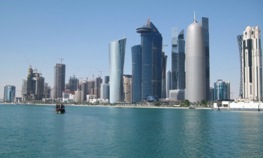 There was no progress on international transport at the United Nations Climate Change Conference COP 18 / CMP 8 at Doha, Qatar. No decision was taken on addressing emissions from international aviation and maritime transport, and no specific reference was made to innovative financing from them. Sectoral approaches, including emissions from international transport, were one of the many issues discussed at the Conference, but proved to be an area in which the positions of the major developed and developing countries were too distant to find a compromise.
There was no progress on international transport at the United Nations Climate Change Conference COP 18 / CMP 8 at Doha, Qatar. No decision was taken on addressing emissions from international aviation and maritime transport, and no specific reference was made to innovative financing from them. Sectoral approaches, including emissions from international transport, were one of the many issues discussed at the Conference, but proved to be an area in which the positions of the major developed and developing countries were too distant to find a compromise.
The AWG LCA track where international transport has been discussed since 2007 has now been terminated. The work program on Long-Term Finance (LTF) was extended for one year, and thus potential financing from international transport may be discussed there. Addressing emissions from international transport may be discussed under the ADP track at some stage, in particular to raise the pre-2020 emission reduction ambition.
In 2013 further discussions on this topic are expected in the respective dedicated organizations, namely at the International Civil Aviation Organization (ICAO) and the International Maritime Organization (IMO), including through the ICAO’s High-level Group on International Aviation and Climate Change (HGCC). Progress in the ICAO would likely help achieve progress in a similar debate in the IMO. However the gap between the Parties’ positions is significant and cannot be underestimated.
We participated actively in the conference, and held an official side event on the Rebate Mechanism (RM).
Conference key details, and acronyms
- The UN Climate Change Conference 2012 in Doha, Qatar was held from 26 November to 8 December 2012, and comprised:
- the eighteenth session of the Conference of the Parties to the UNFCCC (COP 18);
- the eighth session of the Conference of the Parties serving as the Meeting of the Parties to the Kyoto Protocol (CMP 8);
- as well as meetings of five subsidiary bodies:
- the thirty-seventh session of the Subsidiary Body for Implementation (SBI 37);
- the thirty-seventh session of the Subsidiary Body for Scientific and Technological Advice (SBSTA 37);
- the second part of the seventeenth session of the Ad hoc Working Group on Further Commitments for Annex I Parties under the Kyoto Protocol (AWG-KP 17);
- the second part of the fifteenth session of the Ad hoc Working Group on Long-term Cooperative Action under the Convention (AWG-LCA 15); and
- the second part of the Ad hoc Working Group on the Durban Platform (ADP 1).
The decisions adopted are available at the COP 18 / CMP 8 web page.
For more details see a summary of the Conference published by the International Institute for Sustainable Development.
Outlook for carbon pricing of international transport
No decision was taken on the sectoral approaches and international transport at Doha, while the AWG-LCA was terminated after being extended three times (it was established in 2007 for two years), alongside the AWG-KP. Given the uncompromising positions of the developed and developing countries on sectoral approaches, it seems unlikely that this topic will be negotiated separately and successfully closed in the near term at the UNFCCC. However, international transport can be discussed under the ADP negotiations at some time, in particular regarding raising mitigation ambitions in the pre-2020 period.
Both the IMO and ICAO will very likely continue to work on various approaches to reduce greenhouse gas (GHG) emissions from international maritime transport and aviation, including carbon pricing. However, the lack of progress at Doha, and in particular the lack of signal on whether and how to address the principles and provisions of the UNFCCC convention in the area of international transport may negatively impact discussions in both organizations. However, given that the debacles at both organizations on global approaches to address GHG emissions intensified last year, if greater political will is shown by major countries, progress can be made in 2013.
In the IMO, the resolution on technical co-operation relating to energy efficiency of ships has not been completed over the last two sessions of the Marine Environment Protection Committee (MEPC) – some solution is likely in 2013, and the discussions on market-based measures could then proceed.
More progress may occur at the ICAO in 2013, given the recently established HGCC . This group aims to find a political way forward, including on carbon pricing of international aviation and on the controversy around the inclusion of international aviation in the EU ETS in 2013. Progress in the ICAO would likely help achieve progress in a similar debate in the IMO.
Our activities at Doha
At Doha our focus was to advance the understanding and political acceptance of how to operationalize equity between different countries through compensatory transfers or rebates, as proposed in the Rebate Mechanism (RM); in particular regarding the generic RM add-on option that may be integrated with any type of proposal for carbon pricing of international shipping (and aviation).
In addition to various in-depth discussions, we held a well attended official side event entitled “Ensuring fair and effective carbon pricing of international transport” on November 27, 2012. At the event the recent additional analytical work on RM was also presented and debated, including on impact of long trading distances.
- For details see:
- Presentation
 (1 MB)
(1 MB)
- RM Fact Sheet
 (0.9 MB).
(0.9 MB).
Increasing ambitions in Bonn
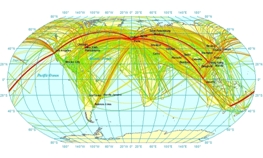 Increasing mitigation and financing ambitions through action on international transport was the topic of our side event at the Bonn Climate Change Conference, June 2013. See the Presentation
Increasing mitigation and financing ambitions through action on international transport was the topic of our side event at the Bonn Climate Change Conference, June 2013. See the Presentation ![]() (1 MB) and the new RM Aviation Fact Sheet
(1 MB) and the new RM Aviation Fact Sheet ![]() (1.3 MB). The presentation was focused on international aviation and included new maps for: (1) international aviation carbon footprint (concentrated in North, as shown), and (2) potential burden of aviation carbon pricing (which, as % of GDP, would be the largest in South). Application of the Rebate Mechanism (RM) to address the disproportional burden on some of the poorest countries was presented and debated.
(1.3 MB). The presentation was focused on international aviation and included new maps for: (1) international aviation carbon footprint (concentrated in North, as shown), and (2) potential burden of aviation carbon pricing (which, as % of GDP, would be the largest in South). Application of the Rebate Mechanism (RM) to address the disproportional burden on some of the poorest countries was presented and debated.
The side event, held on 7 June, was dedicated to carbon pricing of international transport as a mechanism to increase mitigation and financing ambitions for climate change action, while delivering on equity. It was focused on the need for and ways to ensure fair and effective carbon pricing of international aviation and shipping (see the Event flyer ![]() , 0.5 MB)
, 0.5 MB)
The need for fair and efficient carbon pricing of international transport
At the event we have argued again to address equity in order to enable global action, and increased ambitions, for international transport to reduce emissions and contribute to climate change adaptation, in particular by the relatively better-off passengers flying internationally.
To add to the previous results for shipping, we have also presented new calculations for international aviation emissions using two distinctive views:
View 1: CO2 footprint of international aviation
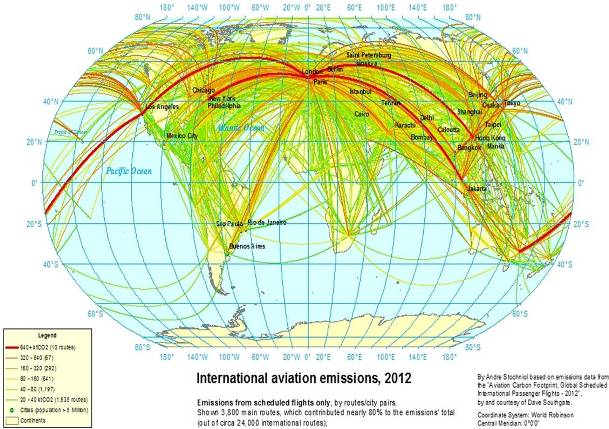
As expected carbon footprint of international aviation is largest on routes to/from certain high-income countries, primarily in North. This includes the United Kingdom, as 8 out of 10 routes with the greatest carbon footprint originate or end at London Heathrow airport (as shown).
View 2: Burden of carbon pricing, as % of GDP

Perhaps surprisingly to some, the largest burden of carbon pricing of international aviation (as % of GDP) may fall on some of the poorest countries (in South) as shown above. This would be the case, unless the regressive character of carbon pricing is somehow dealt with, for instance through a rebate mechanism/rebates, or similar. The 10 most impacted countries shown are all Small Island Developing States (SIDS), with some also being Least Developed Countries (LDCs). If not addressed, the burden on these countries from carbon pricing of international aviation may be 10 times+ greater than the world average.
Rebate Mechanism (RM) proposal for international transport
Shortest definition (c. 140 characters)
All ships/planes pay for their emissions. Certain countries obtain rebates, and the remaining revenue goes to climate change action, including in the sector.
RM could apply to any revenue raising market-based measure (MBM), such as a levy/charge or ETS.
How could RM work in aviation?
The RM could be integrated with a levy proposal as shown below, in which the central Emissions Registry would ensure low cost and easy enforcement through Air traffic control.
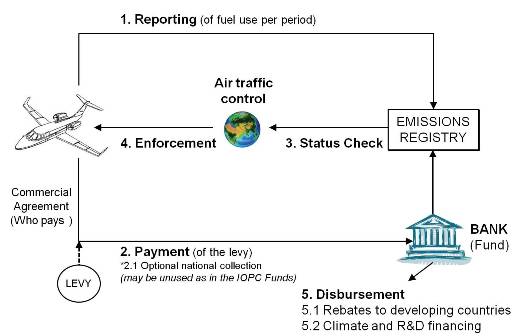
For the IMERS proposal for shipping (aka RM integrated) see slide #10 in the presentation, and various backup slides, or check the IMERS (RM integrated), or the Fact. For the RM add-on details, including draft legal text, check the Rebate Mechanism (RM add-on).
We tentatively call the above integration an IA Fund, for an International Aviation Fund for Sustainable Development, for which the shortest description is as follows.
IA Fund proposal for aviation (in 140 characters)
A global levy on fuel for international aviation, with the RM, that may contribute $5bn to climate change action, including in the sector.
For a longer description and further details, see RM Aviation Fact Sheet ![]() (1.1 MB).
(1.1 MB).
Further side event details
Speaker and Panellist
- Andre Stochniol, IMERS
- Erik Haites, Margaree Consultants
Presentation and appreciations
Two versions of the presentation, the aviation and shipping fact sheets, and the event flyer are available:- Presentation only
 (1 MB).
(1 MB). - Presentation with back-up slides
 (2 MB) (some of the additional slides were used during the debate)
(2 MB) (some of the additional slides were used during the debate)
- RM Aviation Fact Sheet
 (1.3 MB)
(1.3 MB)
- RM Shipping Fact Sheet
 (1.1 MB)
(1.1 MB)
- Event flyer
 (0.5 MB).
(0.5 MB).
Other side events in Bonn
The following related side events took place during the UNFCCC meeting in Bonn:- An Equitable Solution to Curb Aviation Emissions, organized by the Bread for the World (BfdW)
- Market Based Measures for International Transport, organized by the WWF
Low ambitions at ICAO
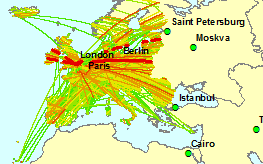 The upcoming 38th ICAO Assembly is likely to agree a narrow scope for any regional carbon pricing of emissions from international aviation. The draft resolution on the issue proposes to limit any such regulation to national airspace of participating countries till a global regime is in place (i.e. by 2020, or longer). This would mean only circa 20% coverage of emissions from extra-European flights, as shown. This may be further limited by exempting flights to and from many developing countries. Together with the other low-ambition elements, the outcome of over 15 years of discussions may be bizarre:
The upcoming 38th ICAO Assembly is likely to agree a narrow scope for any regional carbon pricing of emissions from international aviation. The draft resolution on the issue proposes to limit any such regulation to national airspace of participating countries till a global regime is in place (i.e. by 2020, or longer). This would mean only circa 20% coverage of emissions from extra-European flights, as shown. This may be further limited by exempting flights to and from many developing countries. Together with the other low-ambition elements, the outcome of over 15 years of discussions may be bizarre:
practically no emission reductions by 2020, with little afterwards, if any, and without any contributions to climate finance. All these from passengers that can afford to fly internationally and also benefit from the tax-exempt status of fuels used for such flights.
1: Global problem needs a global solution
Consider CO2 emissions footprint of international aviation
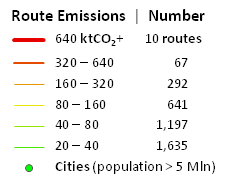
The map illustrates the scale and complexity of international aviation: 200 countries, more than 500 airlines, few thousand aircraft operators, and more than 24 thousand of routes (subset shown). As expected carbon footprint of international aviation is largest on routes to/from certain high-income countries, primarily in North. This includes the United Kingdom, as 8 out of 10 routes with the greatest carbon footprint originate or end at the London Heathrow airport (as shown; see the map's legend, on the left, for emissions per route and number of various routes).
Map details: The map shows emissions from scheduled international flights for 2012, by city pairs (routes). It shows 3,800 main routes out of circa 24,000 international routes.
The routes shown contributed majority of the emissions (nearly 80% of the total for all scheduled international flights; non-scheduled flights are not included).
Map at high resolution (print quality) is available.
The ICAO outcome may mean more talks and cut-down version of the EU scheme till 2020 ...
A quick look at emission coverage of different options for a Market-Based Measure (MBM) for international aviation in the table below illustrates choices. The goal should be option 1 (global MBM with 100% emissions coverage), but the likely outcome till 2020 may be option 3 or 3a.
|
Option |
MBM description |
Coverage, approx. % |
|
1 |
Global MBM (decision to develop is proposed) |
100% |
|
1a |
Global MBM, with 1% de-minims activity threshold, exempting routes to/from countries |
60% |
|
2 |
European ETS, applicable to both departing & arriving flights in EEA countries (currently suspended for extra-EEA flights) |
50% |
|
2b |
European ETS, for departing flights only |
30% |
|
3 |
European ETS, national airspace (and all emissions for intra-EEA flights) |
20% |
|
3a |
European ETS, national airspace, and 1% de-minimis exemption for routes to/from developing countries |
15% |
The maps of routes and emissions covered by the regional options 2 and 3 are shown below.
2: Regional approach (based on departing and/or arriving flights)
Map at high resolution (print quality)
The application of that approach has been suspended for extra-European flights in 2012 for a period of one year to allow the ICAO more time to agree global approach.
3: National airspace approach
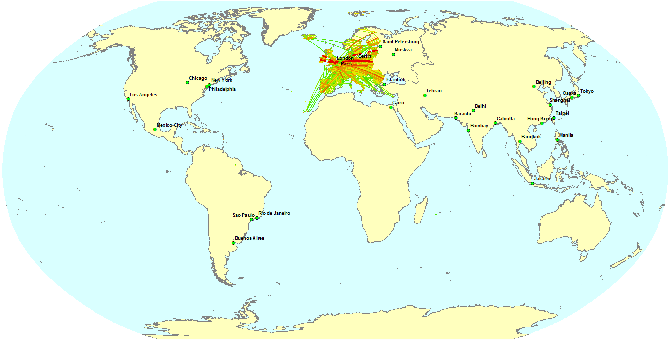
Map at high resolution (print quality)
This approach is severely limiting the amount of emissions from international aviation subject to carbon price, etc., given that majority of emissions on extra European flights take place outside of the countries' national airspace (estimated by us as circa 80%).
How to agree the global approach needed?
The major obstacle in the MBM negotiations is the political need to address national circumstances of various countries, including China, India, but also the US. Furthermore, various poor countries could be unfairly affected through a uniform MBM, notably many small islands developing states and least developed countries as they depend much more than others on international transport for trade and tourism (as reported by us).
There are ways of dealing with all these concerns, for instance through a universal levy on fuel uplifted for international flights charged at the departure country, as it would account for all emissions from international flights while also generating climate finance. To overcome concerns about disproportional impacts on some countries, low-income countries could retain the revenues generated as rebates, high-income countries would contribute 80-90% of the revenues to international climate finance, and countries between these two categories would contribute varying proportions. Such global approach could also be established through an ICAO decision, rather than requiring a new convention or protocol that would take years to develop and enter into force.
Leadership and openness for such ideas is needed if passengers flying internationally are to fairly contribute to action on climate change!
For a detailed proposal, negotiators could contact Dr Andre Stochniol.
